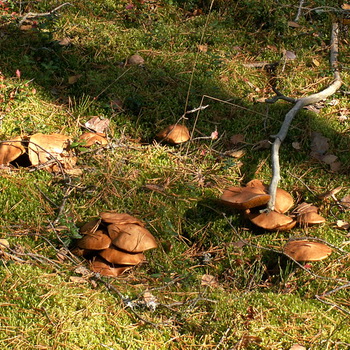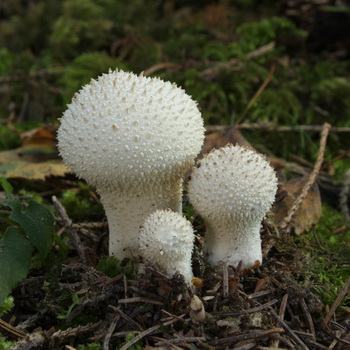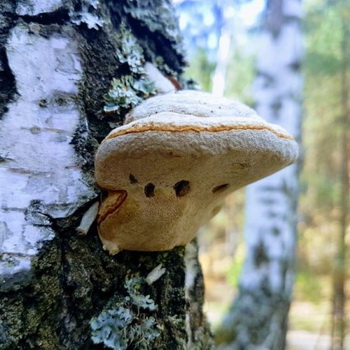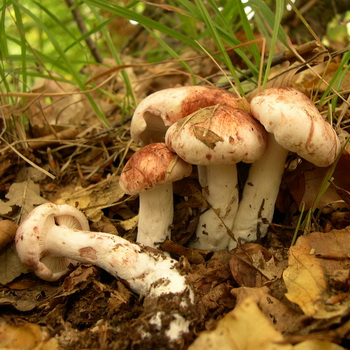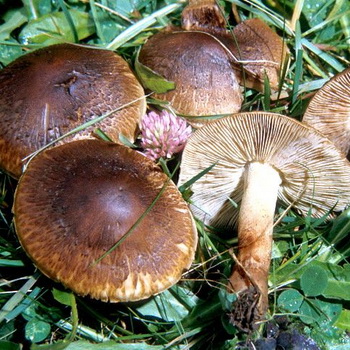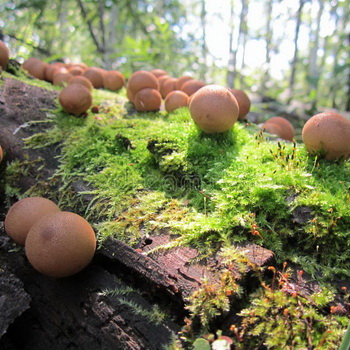Tubular mushrooms: edible and inedible species
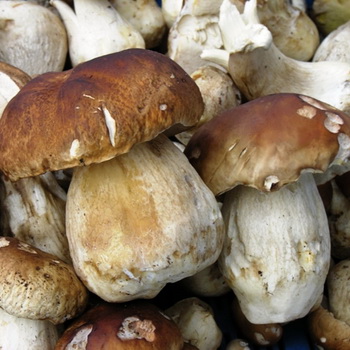
Content
Tubular mushrooms growing on trees and deadwood
Lacquered tinder (Ganoderma lucidum).
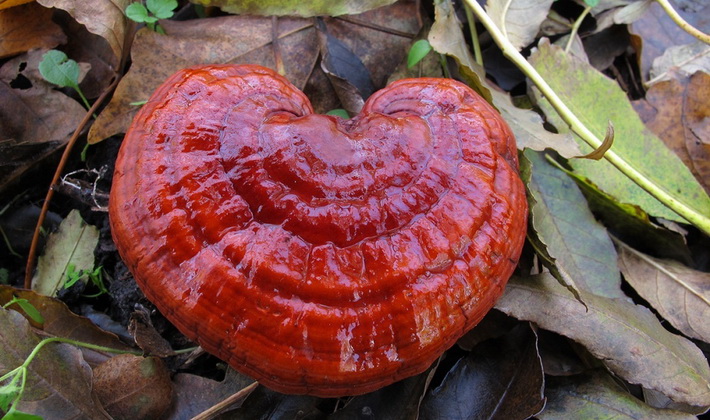
Family: Ganodermataceae (Ganodermataceae)
Season: July - November
Growth: in groups
Description:
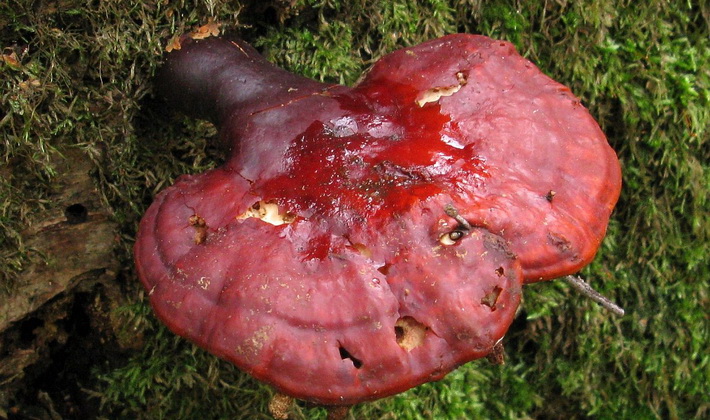
The leg is lateral, uneven and very dense.
The hymenophore is ocher, consists of short tubes, with small rounded pores.
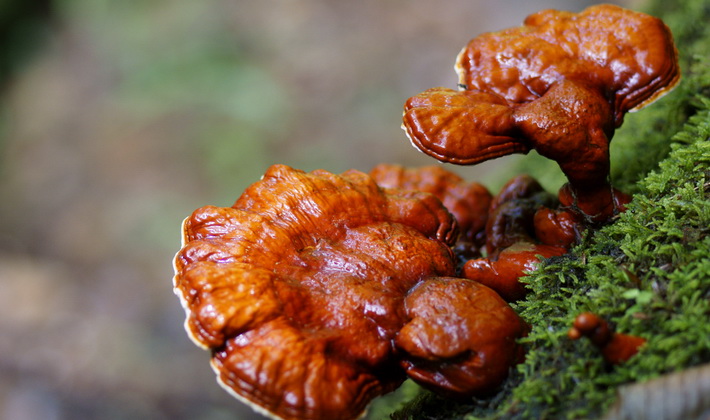
The hat is flat, shiny, uneven. The surface of the hat consists of concentric rings of growth in different colors.
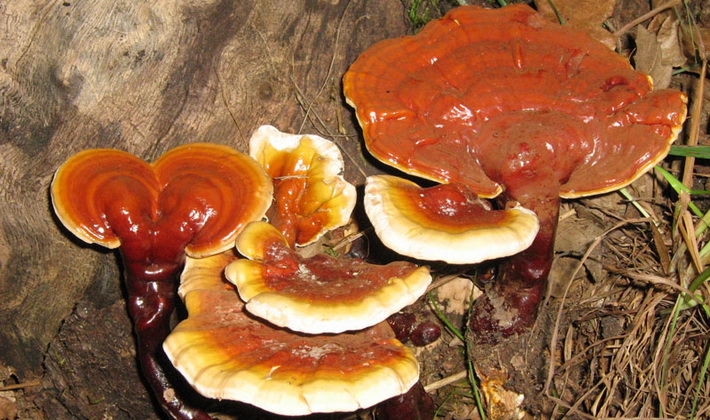
Pulp, woody, buffy color.
This tubular mushroom is inedible; used to treat a number of diseases.
Ecology and distribution:
This is a tubular mushroom that grows on the basis of weakened and dying trees, as well as on deciduous trees. In Russia, distributed in the Stavropol and Krasnodar Territories, in the North Caucasus.
Two-year-old sucker (Coltricia perennis).

Family: Hymenochaetae (Hymenochaetaceae)
Season: beginning of July - November
Growth: in groups

The hat is dry, leathery, with golden brown or brick red concentric circles. The tubular layer is slightly descending, finely porous, brownish.

The leg is narrowed, often with a nodule, velvety, matte, brown.
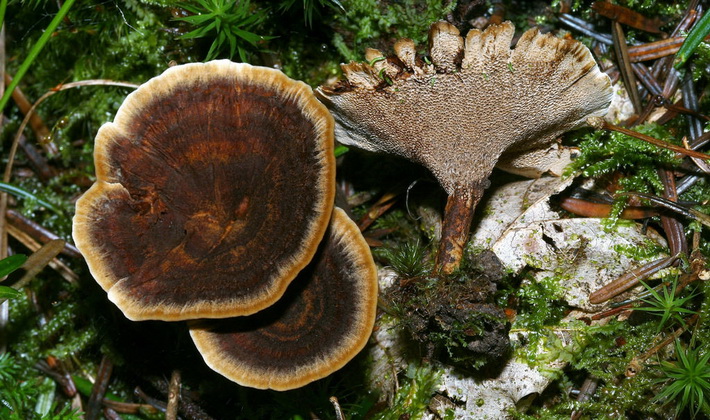
The pulp is leathery, brown, rusty.
Inedible.
Ecology and distribution:
It grows in coniferous and mixed forests, often on sandy soils, in conflagrations.
Chestnut (Polyporus badius).
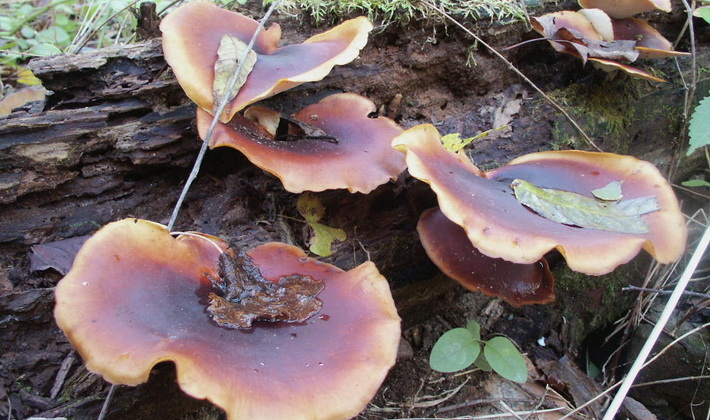
Family: Polypore (Polyporaceae)
Season: mid June - November
Growth: in groups
Description:
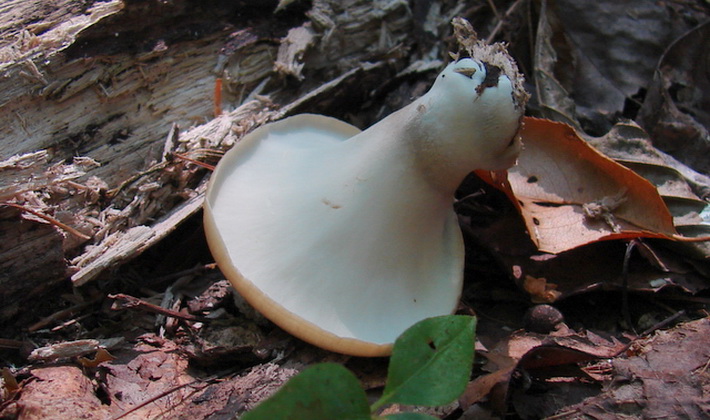
The pulp is leathery, very dense, whitish. The edge of the hat is uneven, wavy.
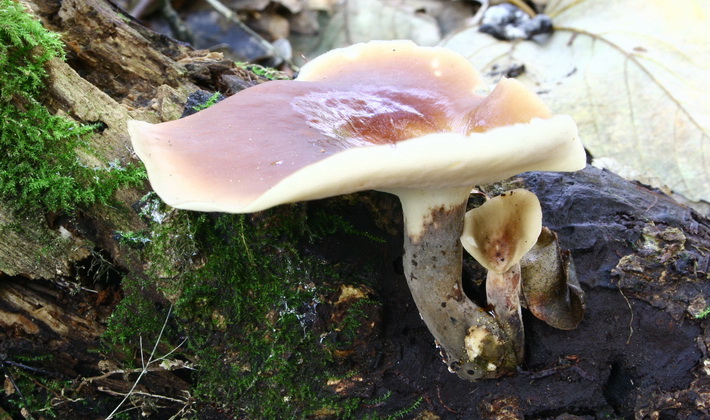
The foot is central or eccentric, strongly narrowed to the base, firm, whitish, half bounded by a dark velvety zone.
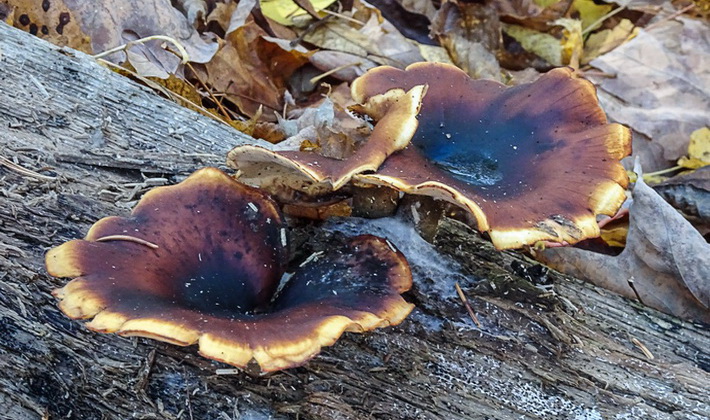
The cap is funnel-shaped, thin, light ocher, yellow-brown or red-brown. The tubular layer is very finely porous, descending on the leg, white or cream, turns yellow when pressed.
Inedible due to hard flesh.
See how this tubular mushroom looks in the photo:

Ecology and distribution:
It grows on stumps, in the woods, in parks, on felling of deciduous species (birch, oak, alder, linden). Rarely does this tubular mushroom grow on living trees. Prefers damp places. It is common and plentiful.
Next, you can see the photos and names of tubular mushrooms that turn blue on the cut.
Tubular mushrooms that turn blue on a cut
Beautiful boletus (Boletus calopus).
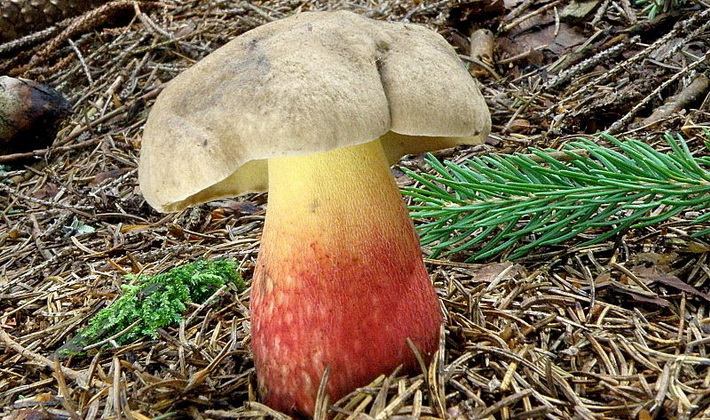
Family: Flight (Boletaceae)
Season: July - October
Growth: singly or in small groups
Description:
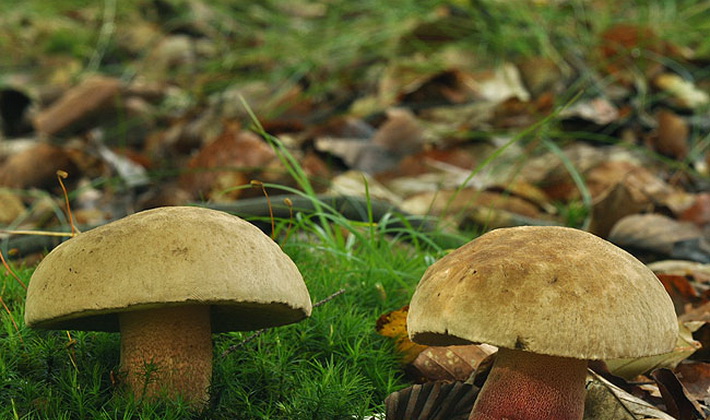
The cap is hemispherical, later convex. The skin is dull, dry, brownish-brown. The tubular layer is yellow, the pores are rounded, small, and when pressed, turn blue.
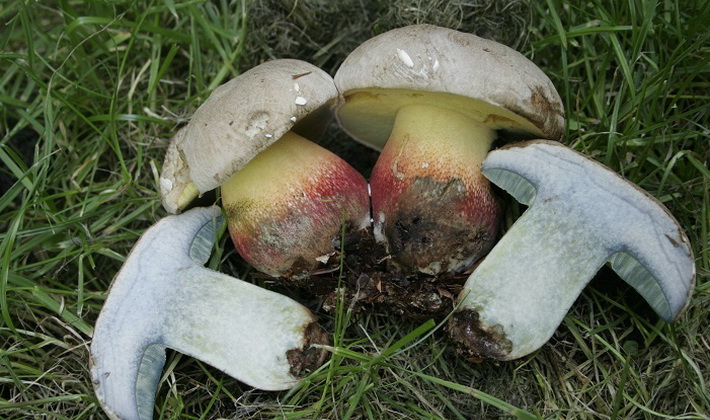
The flesh is whitish or light cream, sometimes it turns blue on the cut, it tastes bitter.
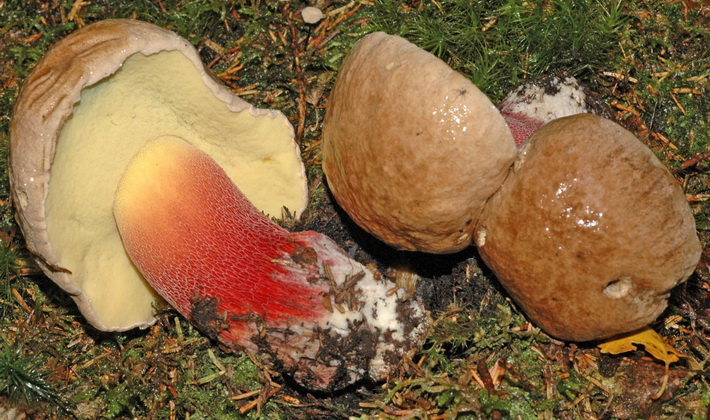
The pedicle is initially barrel-shaped, then club-shaped, the color above is lemon yellow with a white net, in the middle it is carmine red with a red net, and the bottom is brown-red.
Inedible due to an unpleasant bitter taste.
Ecology and distribution:
It grows in coniferous, oak and broad-leaved forests. Prefers acidic sandy soils. Distributed in Europe and in the south of the European part of Russia.
Speckled oak (Boletus luridiformis).
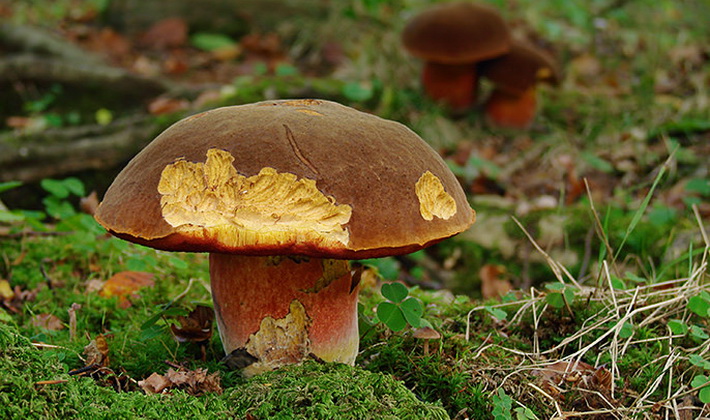
Family: Flight (Boletaceae)
Season: mid May - October
Growth: singly or in small groups
Description:
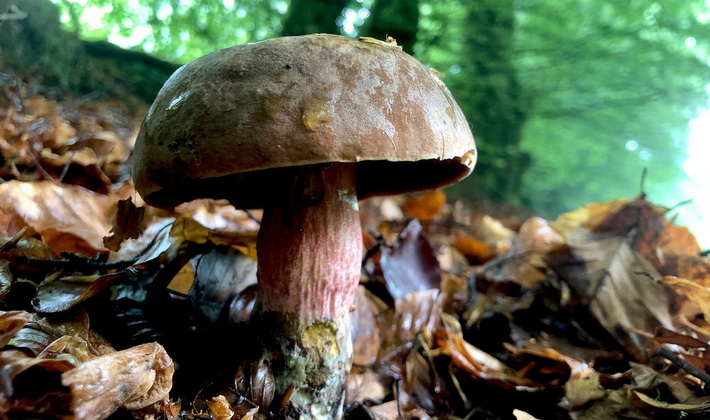
The skin is velvety, matte, occasionally mucous, brownish-brown, with pressure it darkens or blackens. The cap is hemispherical, later cushioned.
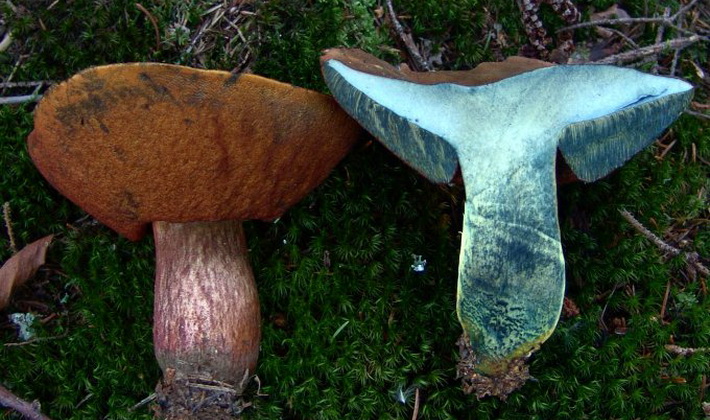
The flesh is yellowish, quickly turns blue on the cut, brownish in the leg. The tubes are yellow-olive, the pores are rounded, small, yellow, later turn red, when pressed, they turn blue.
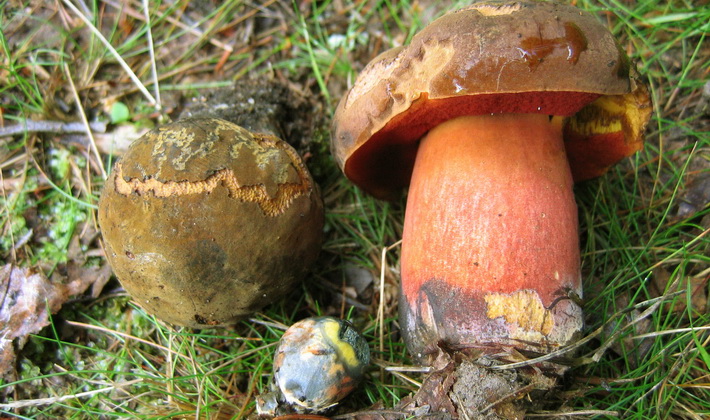
The leg is barrel-shaped, later club-shaped, yellow-red, without a mesh pattern, with red scales.
Conditionally edible mushroom. It is used fresh (after preliminary boiling) or dried.
Ecology and distribution:
A tubular mushroom called speckled oak tree forms mycorrhiza with beech, oak, spruce, and fir. It grows in forests and marshes, among mosses, prefers acidic soils. It is found in Russia in the Caucasus, in Eastern Siberia, less often in the European part and Western Siberia.
Olive-brown oak (Boletus luridus).

Family: Flight (Boletaceae)
Season: July - September
Growth: singly or in small groups
Description:

The flesh is yellowish, dense, reddish at the base of the leg, turns blue, then turns brown. The skin is velvety, mucous in wet weather, the color varies from light brownish-yellow, darkens when touched.
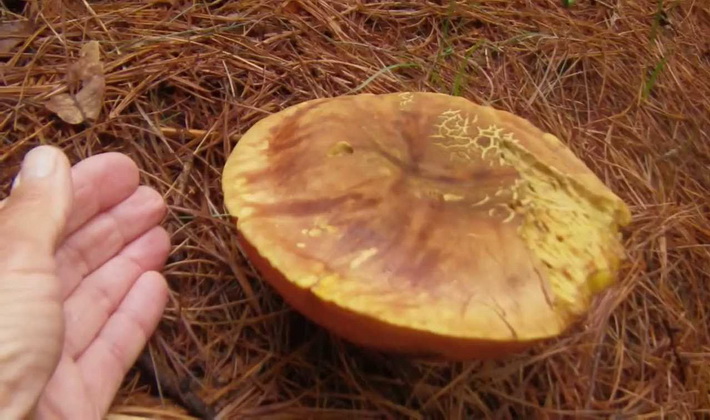
The cap of this tubular mushroom is hemispherical or convex, rarely flat. The tubes are loose, yellow, later greenish; the pores are round, very small, reddish, turn blue when pressed.
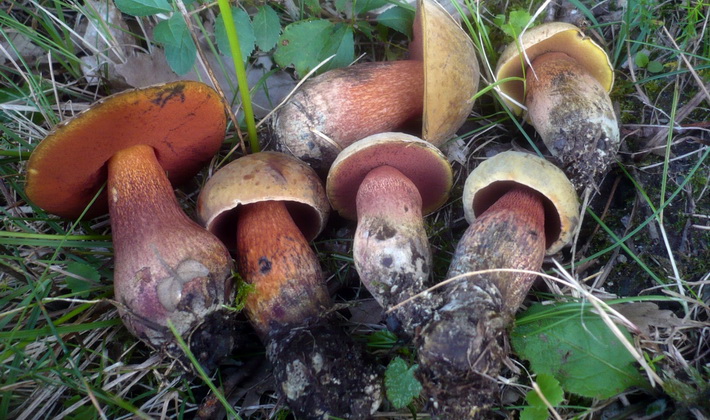
The leg is club-shaped, yellow-orange, with a convex brownish-red mesh pattern.
Conditionally edible mushroom. Raw or undercooked can cause poisoning.
Ecology and distribution:
It grows in deciduous and mixed forests on calcareous soils, mainly in bright, well-sun-warmed places. Distributed in Europe, the Caucasus, rare in Western Siberia and the south of the Far East.
Polish mushroom (Boletus badius).
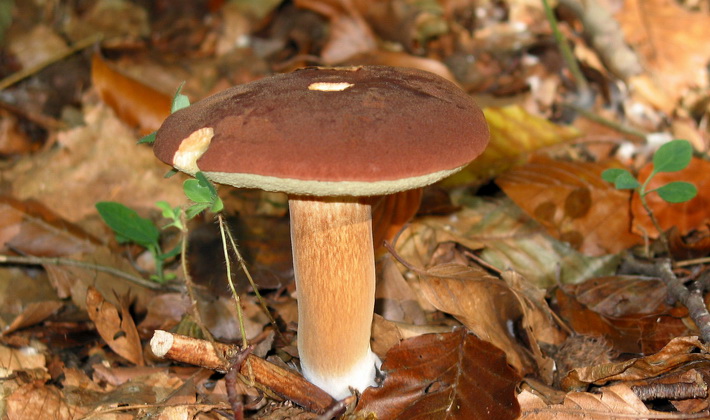
Family: Flight (Boletaceae)
Season: June - November
Growth: singly or in rare groups
Description:

The cap of young mushrooms is semicircular, later - pillow-shaped.
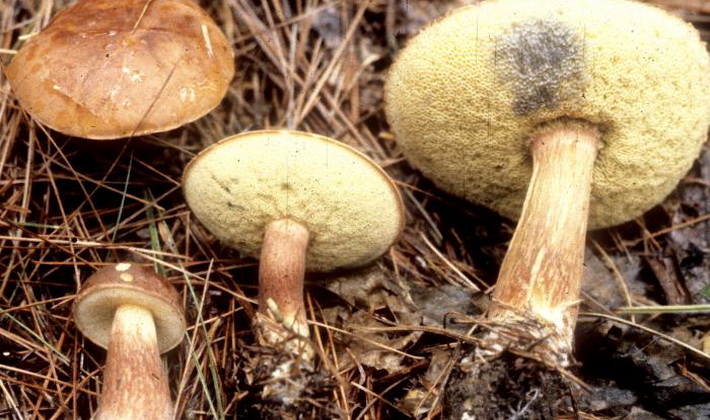
Leg is fibrous, brown or yellow with reddish-brown fibers, lighter above and below.

The pulp is dense, yellowish; on the cut, it turns blue slightly, then it brightens again in the hat, turns brown in the leg. The tubes turn blue when pressed. The skin is brown, cannot be removed, it feels smooth, slightly sticky in wet weather. The tubular layer with a small indentation at the leg, yellow on the stumps.
Good edible mushroom.
Ecology and distribution:
It forms mycorrhiza with pine, less often with other species. This is a tubular mushroom growing, growing in coniferous, rarely deciduous forests, most often on sandy soils, sometimes grows on the bases of trunks.
Girl's boletus (Boletus appendiculatus).
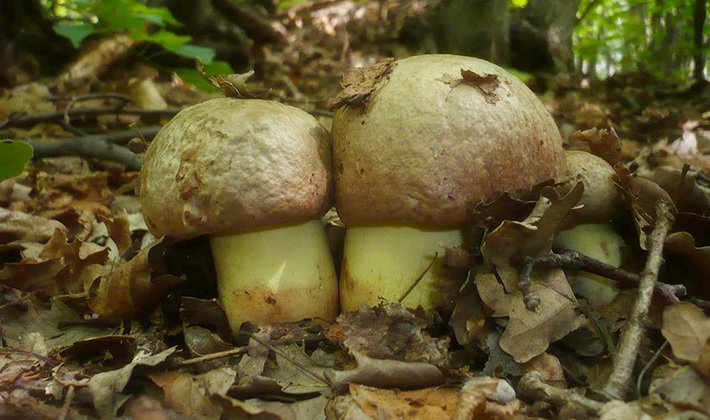
Family: Flight (Boletaceae)
Season: June - September
Growth: singly or in small groups
Description:
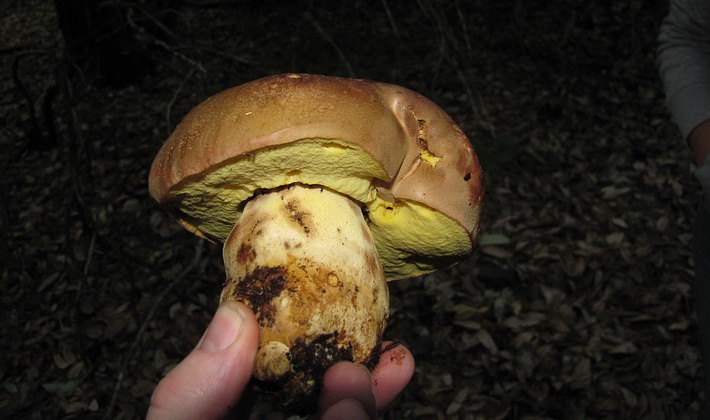
The skin is thin, golden or reddish brown, felt. The hat is convex with the edges slightly bent inward.
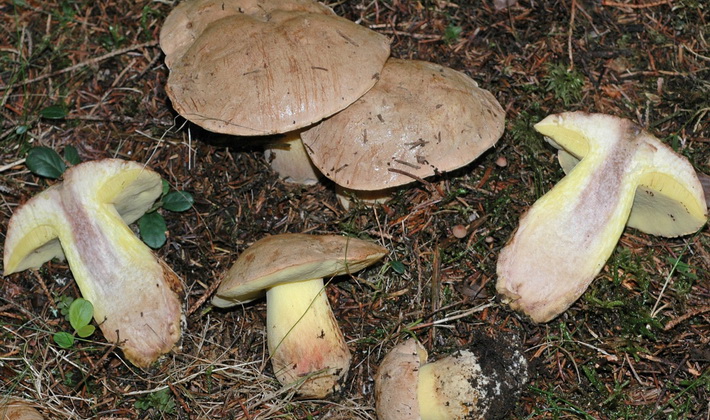
The pulp is dense, light yellow, blue at the cut, with a pleasant aroma.
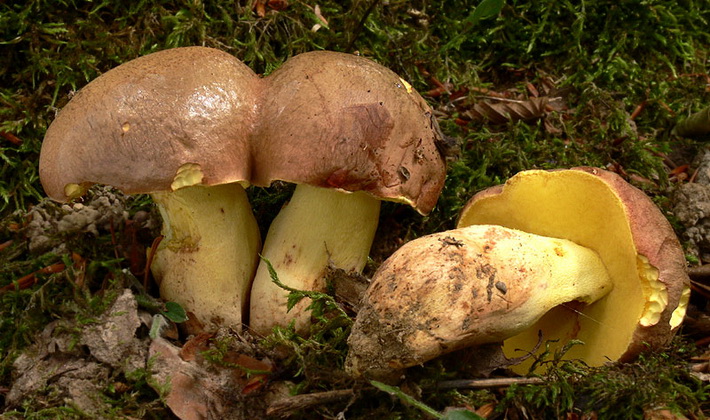
The base of the leg is conically pointed. The foot is light, covered with a mesh pattern. The tubular layer has grown with a tooth, 1-2.5 cm thick, bright lemon yellow, turns blue when pressed
Tasty edible mushroom.
Ecology and distribution:
Forms mycorrhiza with deciduous trees.It grows in deciduous and mixed forests, usually under oaks, hornbeams and beeches, in the mountains among firs. Prefers calcareous soils. Distributed in regions with a mild climate.
Fissured flywheel (Boletus pascuus).
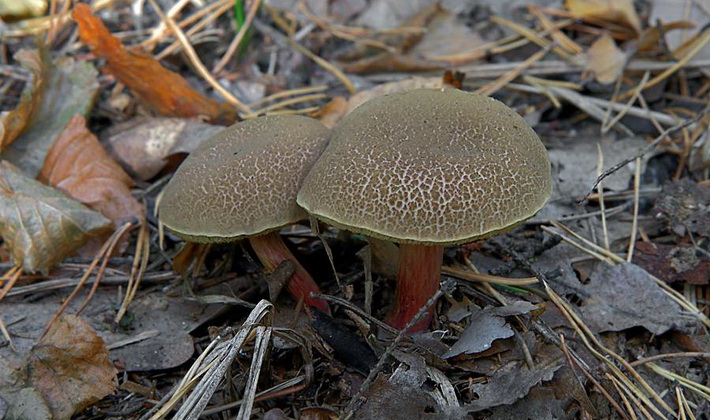
Family: Flight (Boletaceae)
Season: July - September
Growth: in groups
Description:

The cap is convex or cushion-shaped, mesh cracking. The skin is dry, matte, the color is from burgundy red to brown. The tubular layer is large-porous, grown at the foot, yellow tubes, turn blue when pressed.
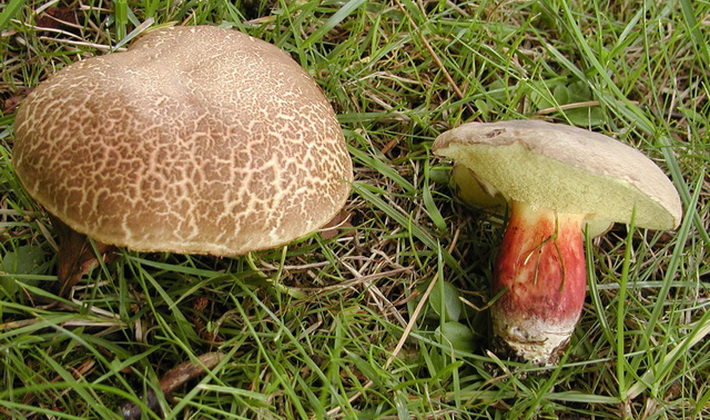
The leg is club-shaped, smooth, finely scaly at the top, light yellow, red below.
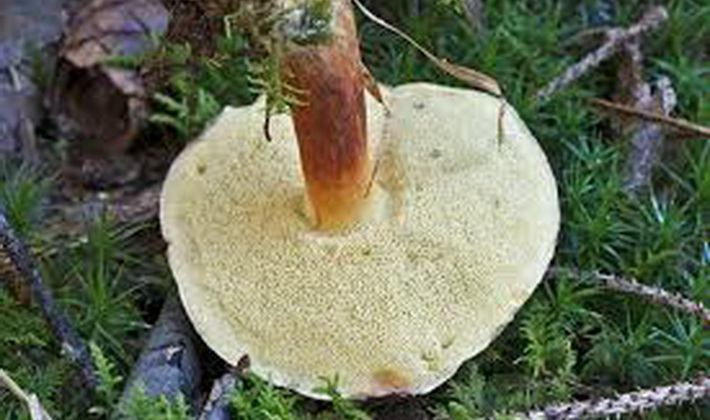
The pulp is whitish or yellowish, reddish at the base of the leg and under the skin of the cap, intensely turns blue on the cut.
The mushroom is edible, but is considered mediocre. It is better to collect young mushrooms. Requires preliminary boiling.
Ecology and distribution:
It grows in deciduous and mixed, and sometimes in coniferous forests on well-loosened acidic soils. It forms mycorrhiza with deciduous trees (often with beech).
Red flywheel (Boletus rubellus).
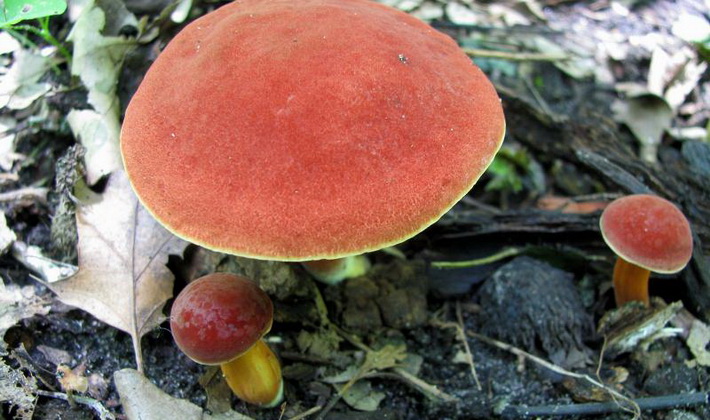
Family: Flight (Boletaceae)
Season: July - September
Growth: in groups and singly
Description:
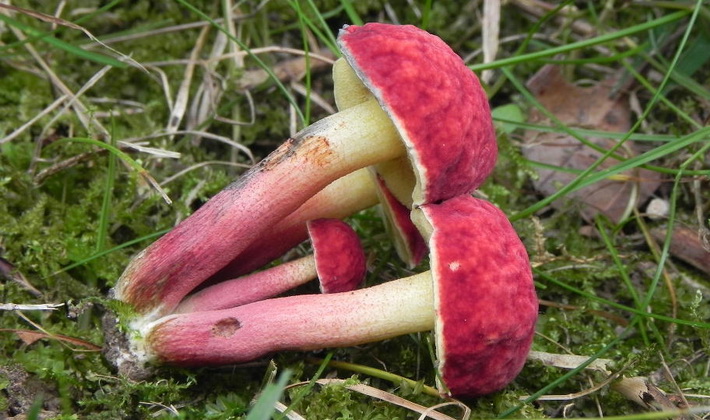
The leg is solid, fibrous, the color under the hat is yellow, closer to the base is reddish or red-brown, with small scales.
The skin is saturated red in color, cannot be removed, in mature mushrooms it is slightly fissured.
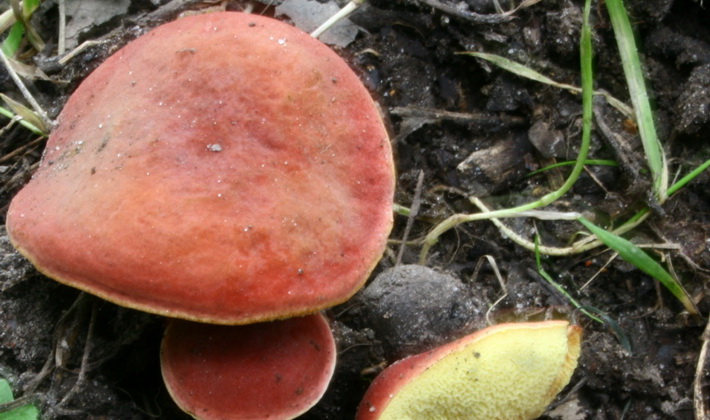
The cap is initially convex in the shape of a pillow; sometimes it spreads in mature mushrooms. The tubular layer of the cap is yellow, slowly turning blue when pressed; in mature mushrooms it becomes brownish.
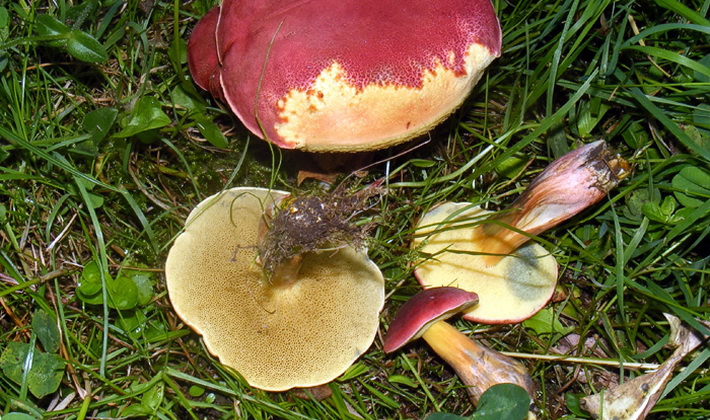
The pulp is dense, yellowish, turns blue
Edible tubular mushroom, has a pleasant smell, the taste is inexpressive. It is often wormy.
Ecology and distribution:
It grows in deciduous and mixed forests, among low grass or moss. Especially prefers oak groves. Distributed in Europe and the Far East. It is rare.
Green flywheel (Boletus subtomentosus).
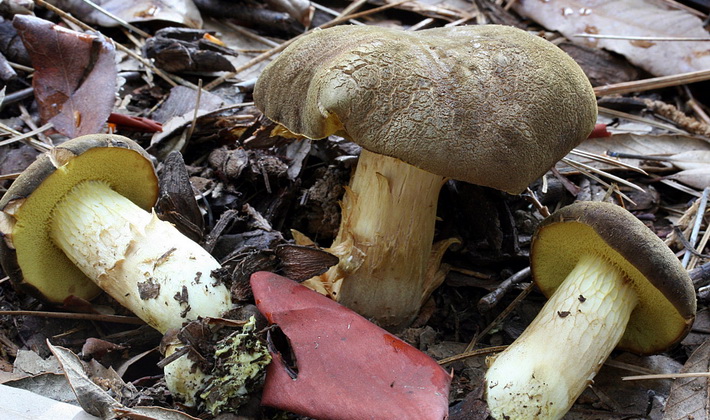
Family: Flight (Boletaceae)
Season: May - October
Growth: in groups and singly
Description:
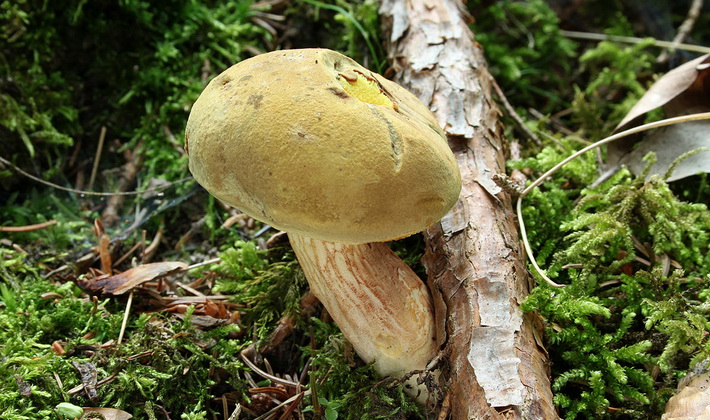
The cap is pillow-shaped, velvety, grayish- or olive-brown or red-brown.

The flesh is loose in the hat, fibrous in the leg, whitish-yellowish, intensely bluish at the cut. The tubular layer is coarse-grained, grown, yellowish, later convex, ocher-yellow, with intense blue pressure.

The leg is smooth, fibrous with a dark brown mesh.
Edible mushroom. Used usually freshly prepared. When drying, it turns black.
Ecology and distribution:
It forms mycorrhiza with both coniferous and deciduous trees. It grows in a variety of forests, often in glades, at the edges of roads. Sometimes found on anthills. In Russia it is ubiquitous.
Satanic mushroom (Boletus satanas).
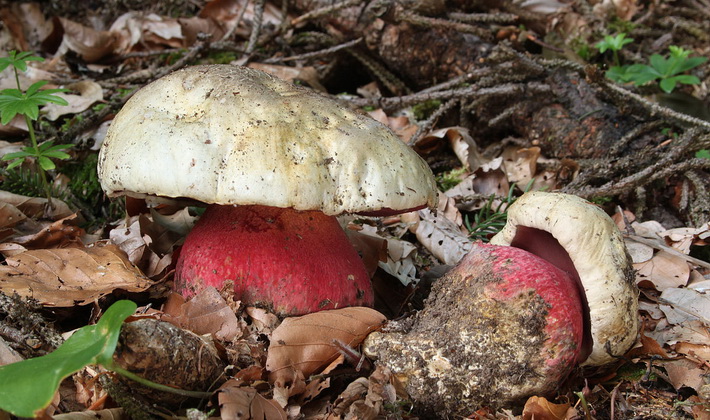
Family: Flight (Boletaceae)
Season: June - September
Growth: in groups and singly
Description:
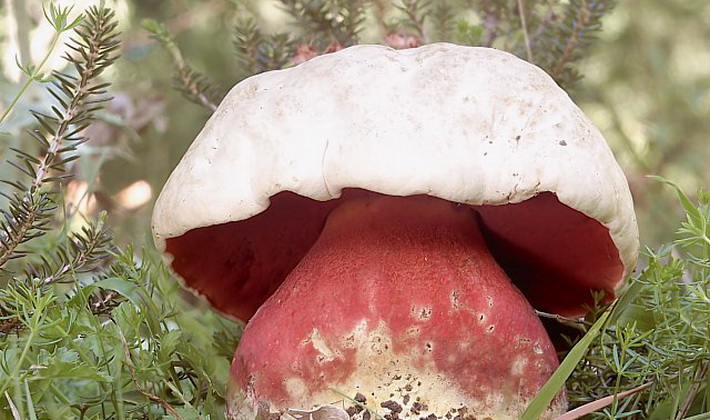
The hat is dry, whitish or gray.
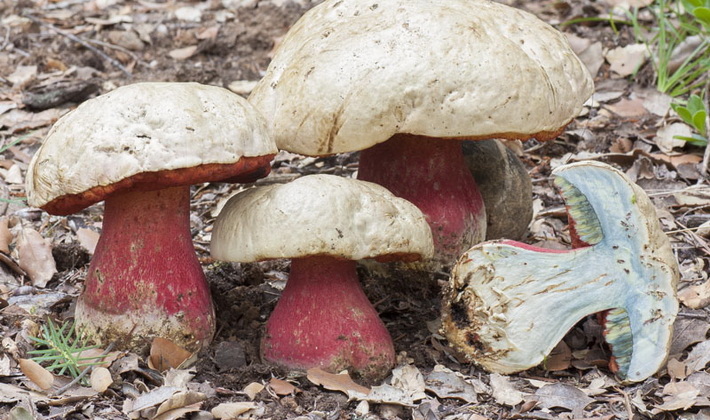
The flesh is white or yellowish, moderately blue at the cut, has an unpleasant odor. The tubes are yellowish, the pores are small, yellowish, later turn red, when pressed, they turn blue.
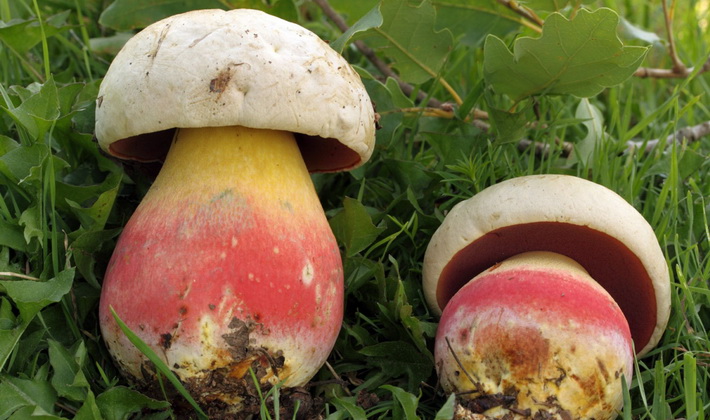
Leg initially ovoid or spherical, barrel-shaped or repetitive, narrowed up, dense, red, yellow above, covered with a mesh pattern with rounded cells.
In its raw form, this tubular mushroom is highly toxic, causing severe digestive upset.
Ecology and distribution:
It grows in bright deciduous forests, mainly on calcareous soils. It forms mycorrhiza with oak, beech, hornbeam, hazel, linden. It is found in Russia in the south of the European part, in the Caucasus, in the south of Primorsky Krai.
Red boletus (Leccinum aurantiacum).
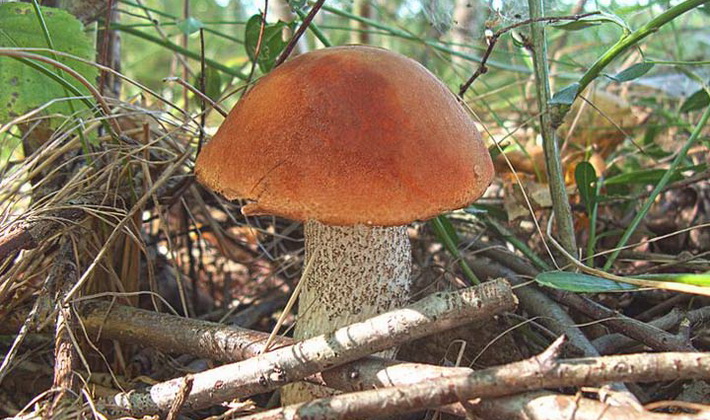
Family: Flight (Boletaceae)
Season: June - October
Growth: single and family groups
Description:
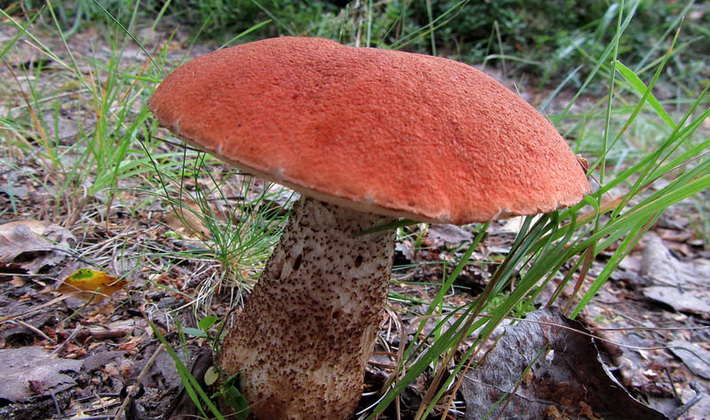
The hat is a pillow-shaped, easily detachable from the leg.

The pulp is fleshy, dense, white, on the cut it quickly turns blue, then blackens.
The skin is red, orange or brownish-red, not removable.
The cap of young mushrooms is hemispherical with the edge firmly pressed to the leg.
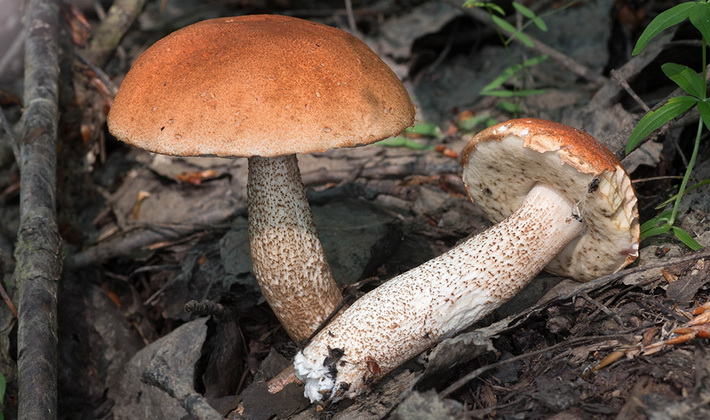
The leg is solid, grayish-white, covered with longitudinal-fibrous scales. The tubular layer is free, 1-3 cm thick with small angularly-rounded pores, white, then brownish-gray, darkens when touched
One of the best edible mushrooms. It is used in fresh (boiled and fried), dried and pickled forms, for salting. It usually darkens during processing.
Ecology and distribution:
It forms mycorrhiza with various species of deciduous trees. It occurs in deciduous and mixed forests under young trees, in deciduous small forests, in glades and along forest roads, in grass. In dry summers, it appears in moist high-stemmed aspen forests. Distributed throughout the forest zone of Eurasia, it is found in the tundra among dwarf birches. Seasonality The first layer ("spikes") - appears from the end of June to the first of July, not abundantly; the second layer - ("stubs") - in mid-July; the third ("deciduous trees") - from mid-August to mid-September.
Variegated oiler (Suillus variegatus).
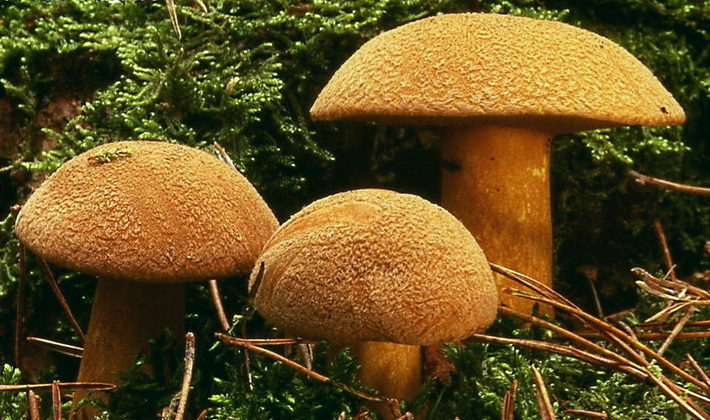
Family: Oiler (Suillaceae)
Season: July - October
Growth: in groups and singly
Description:
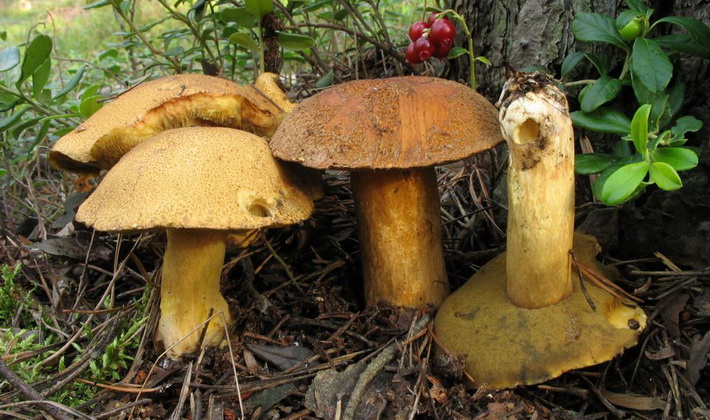
The leg is smooth, yellow, below with a reddish tint.
The peel with fibrous scales, poorly separated from the cap, the color - from olive to brown-reddish and light ocher.
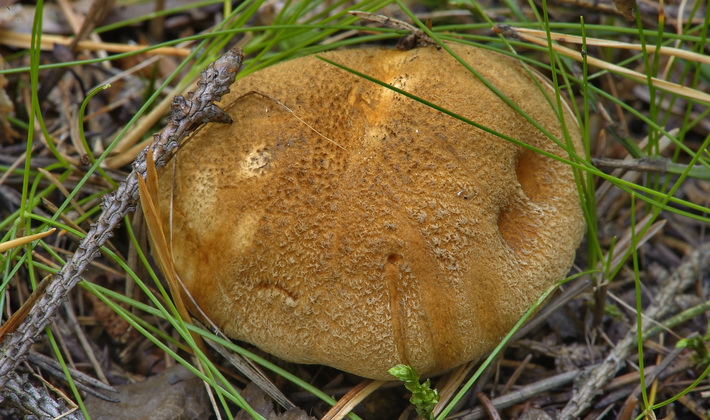
The hat is convex in youth, with a curled edge.

The flesh is yellowish, blue in the section, with the smell of pine needles.
The tubular layer is grown at the legs, yellow tones, the pores are brown, small, rounded.
Edible mushroom. It is used fresh (after boiling), pickled, salted. It darkens during heat treatment.
Ecology and distribution:
Forms mycorrhiza with pine. It grows on sandy (less often stony) soils of coniferous (mainly pine) or mixed forests, often with heather.
Mushrooms with a solid body.
Below is a photo and description of tubular mushrooms with bulging hats:
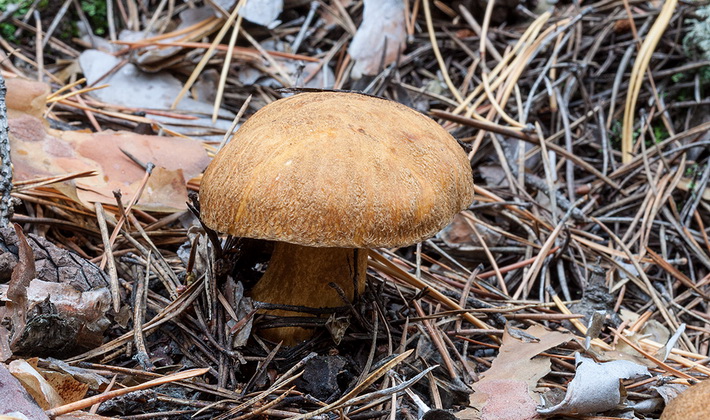
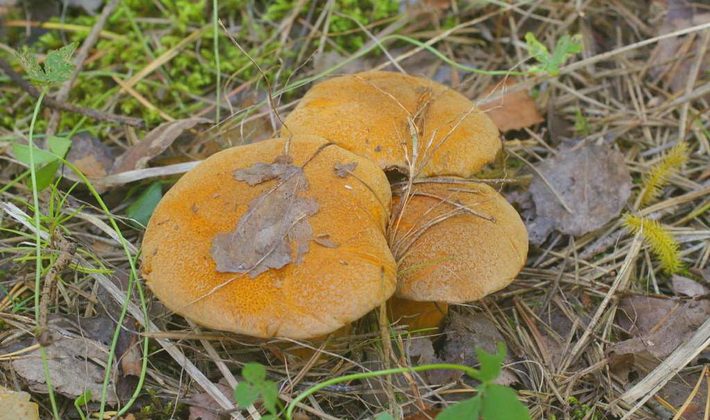
Cap mushrooms
Cep (Boletus edulis).
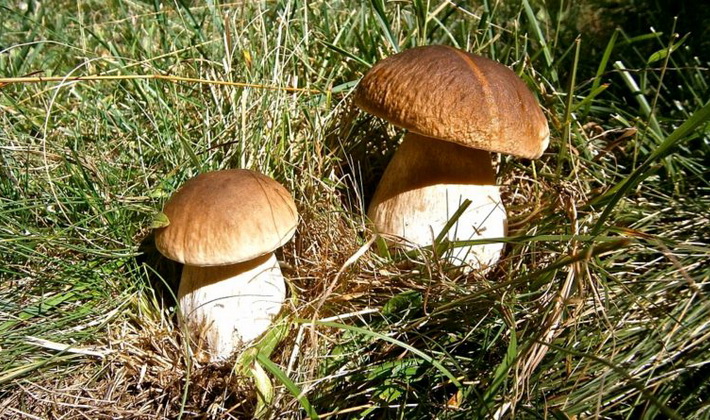
Family: Flight (Boletaceae)
Season: mid June - mid October
Growth: alone in the summer, in the fall - as a group, family
Description:
The skin has grown, the color is from red-brown to almost white, darkens with age. The surface of the legs is whitish, brownish, sometimes reddish, usually covered with a mesh of lighter veins.
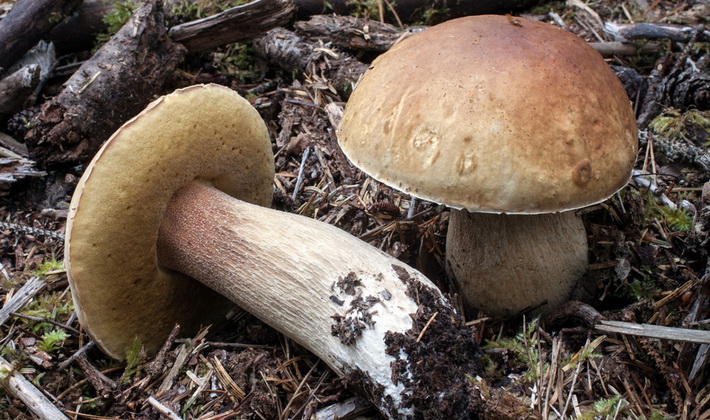
The leg is massive, barrel-shaped or club-shaped, elongates with age. A tubular layer with a deep notch near the leg, is easily separated from the pulp of the hat, light, 1-4 cm thick, pores are small, round.
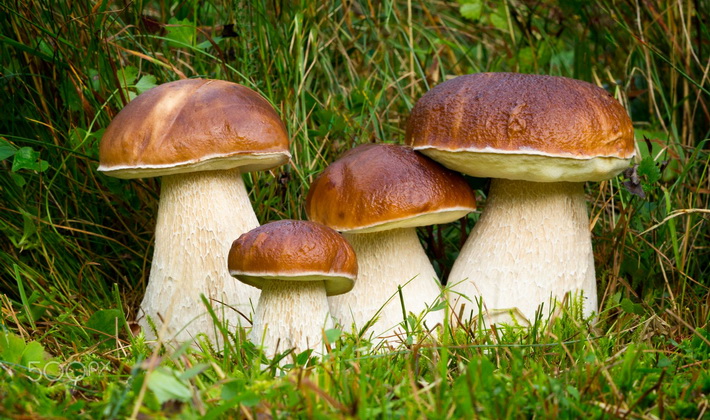
The hat is convex, in old mushrooms it is flat-convex, rarely prostrate. The surface is smooth or wrinkled.
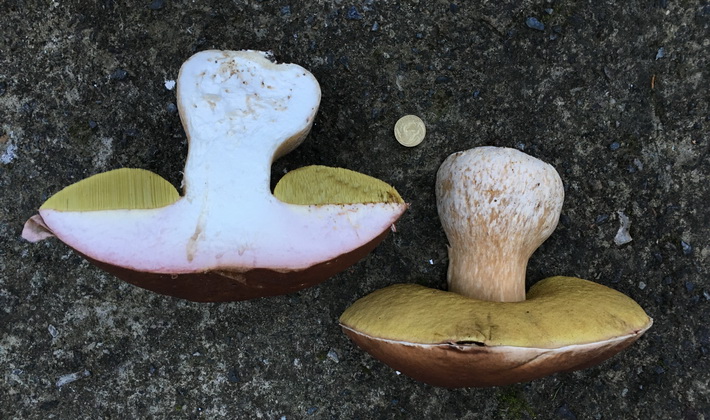
The pulp is strong, juicy-fleshy, fibrous in old specimens, white in young fungus, yellowing with age.
It is considered one of the best edible mushrooms. Preliminary boiling is not required. It is used fresh in the first (gives a bright, transparent broth) and second courses, dried (very aromatic), frozen, salted and pickled.
Ecology and distribution:
It forms mycorrhiza with spruce, pine, birch, oak. It grows in deciduous, coniferous and mixed forests. He does not like damp places. In summer it is found in young groves and plantings, in autumn - deeper in the forest, near old trees, along paths and abandoned roads. During the season, three layers of fruiting are distinguished: at the end of June (spikes are rare and sporadic), in mid-July (spruces - the harvest layer), in the second half of August and in the first half of September (deciduous - massively).
Mushroom boletus (Boletus reticulatus).
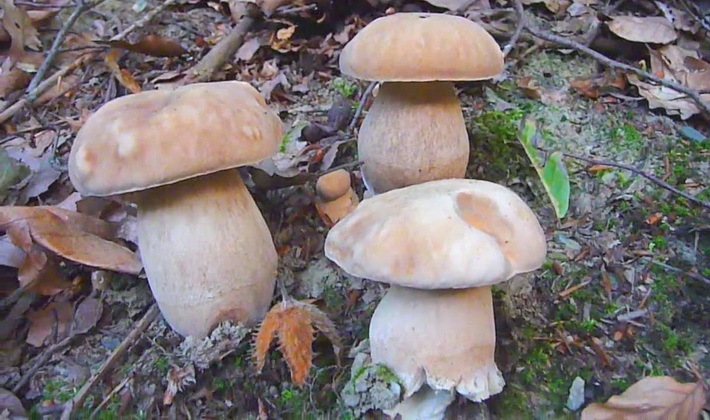
Family: Flight (Boletaceae)
Season: end of May - October
Growth: singly or in small groups
Description:

The cap is initially hemispherical, later strongly convex.

Leg tapering upward, brownish, covered with a lighter large mesh pattern. Skin is light brown, matte, velvety, dry.
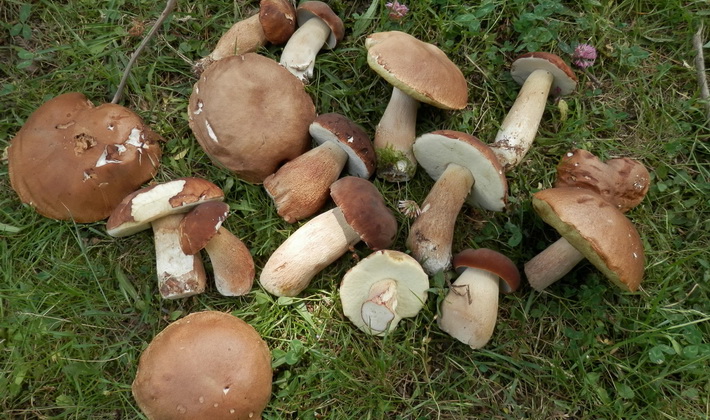
The pulp is dense, white, with a mushroom smell and a sweetish or nutty taste. The tubular layer is loose or adherent with a notch, first white, then greenish-yellow. The pores are small, rounded
It is used and appreciated in the same way as porcini mushroom.
Ecology and distribution:
It grows in bright deciduous forests, usually under oaks and beeches. Prefers dry alkaline soils. It is more common in mountainous and hilly areas. On the territory of Russia is found in the Krasnodar Territory.
Flywheel parasitic (Boletus parasiticus).

Family: Flight (Boletaceae)
Season: summer autumn
Growth: in groups
Description:
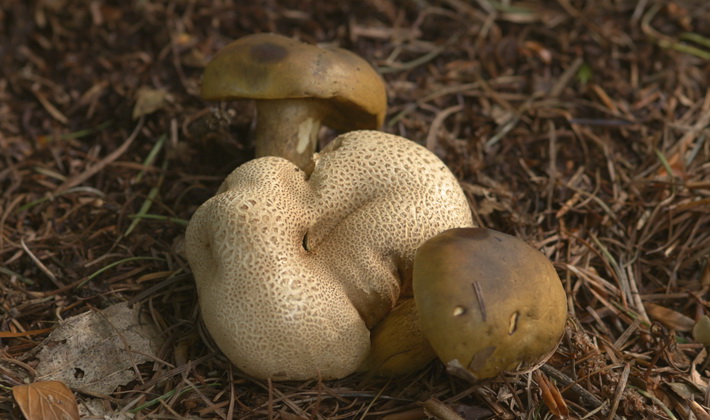
The tubular layer is creeping down, 3-7 mm thick, pores from lemon yellow to rusty brown, wide. The cap is convex, slightly oily, the color is from yellow to buffy brown.
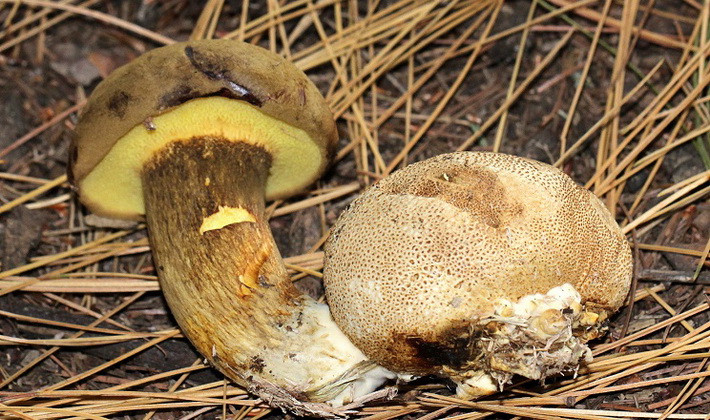
The pulp is light yellow.
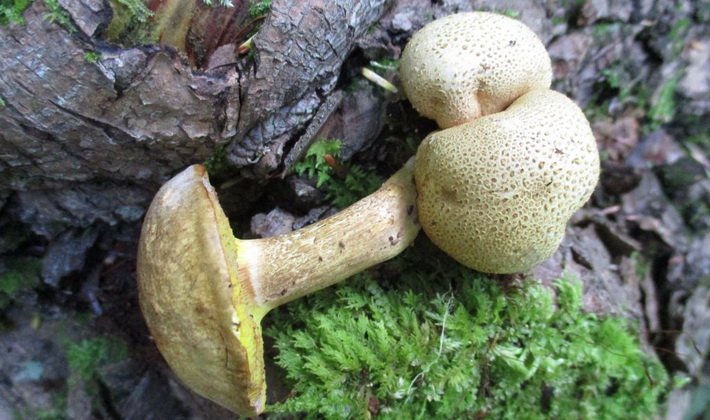
The leg is continuous, cylindrical.
The mushroom is edible, but has an unpleasant taste.
Ecology and distribution:
It grows on living fruit bodies of pseudo-raincoat (Scleroderma). Distributed in Europe and eastern North America. It is rare.
Powdered flywheel (Boletus pulverulentus).
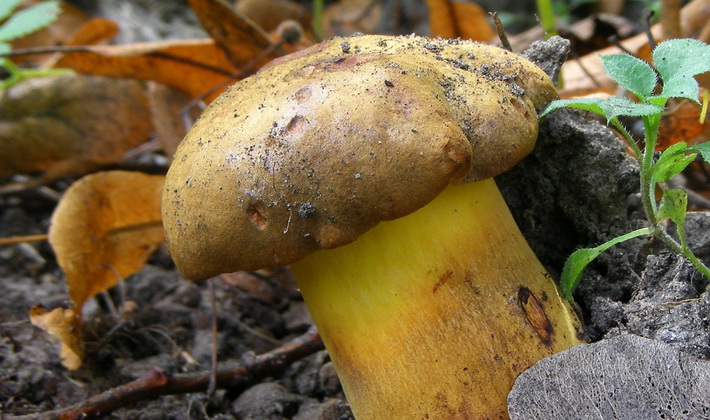
Family: Flight (Boletaceae)
Season: Aug. Sept
Growth: in groups and singly
Description:
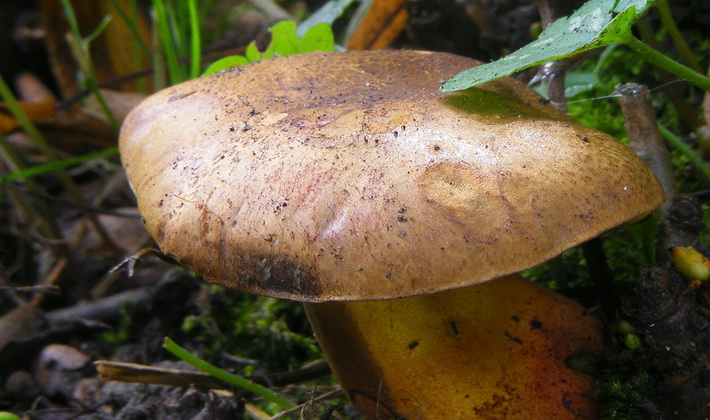
The hat is first hemispherical, then convex, of brown tones, in a wet state it is sticky-mucous.

Leg is fleshy, strong, yellow above, rusty brown at the base.
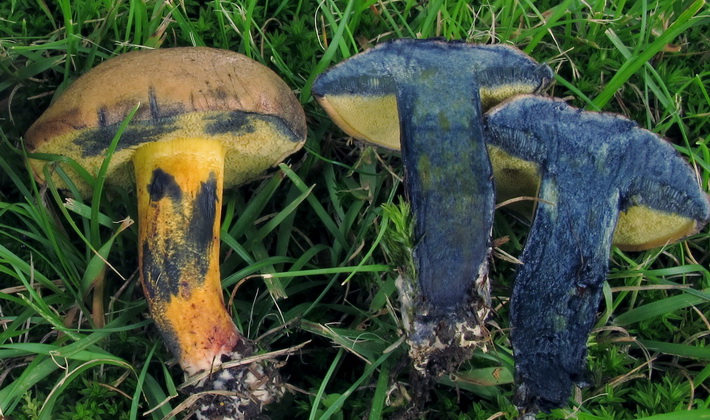
The pulp is solid, yellow, on the cut it quickly turns into a dark blue color.
The tubular layer is yellow; in older specimens it is tan.
The mushroom is edible, but does not differ in special tastes.
Ecology and distribution:
Grows in deciduous and mixed tubular layer forests (often with oak, spruce). Relatively rare. It occurs mainly in warm regions (Caucasus, Far East).
Below is a description of tubular mushrooms with a white hymenophore.
Examples of tubular mushrooms with white hymenophore
Winter fungus (Polyporus brumalis).
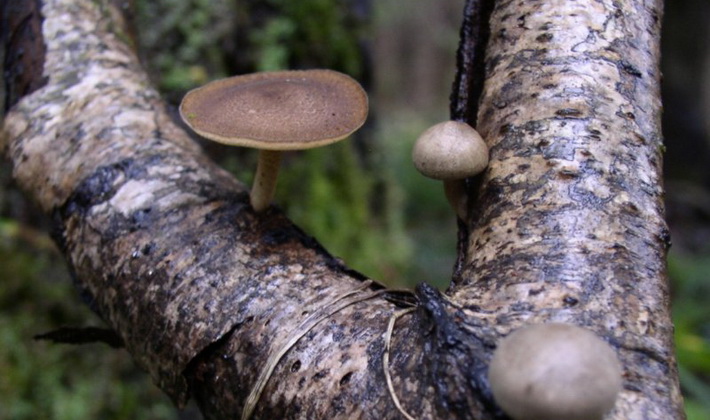
Family: Polypore (Polyporaceae)
Season: May - December
Growth: in small groups and singly
Description:
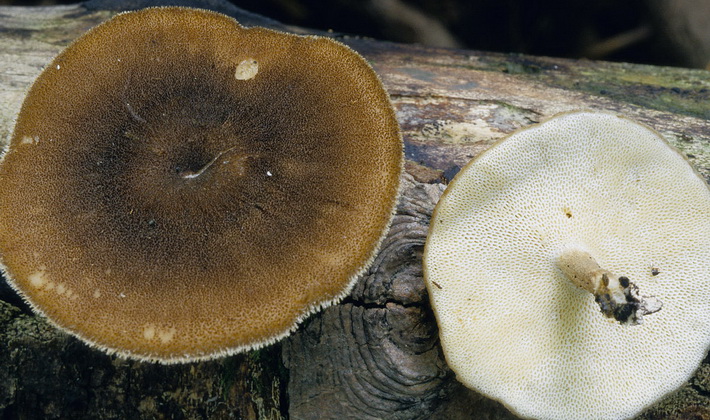
The pulp is elastic, in the leg it is dense, later it is leathery, whitish or yellowish. The hymenophore is finely tubular, descending along the leg, white, later cream.
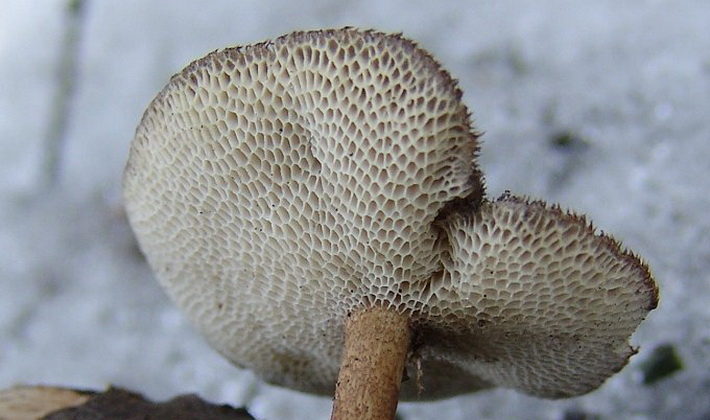
The leg is firm, velvety, gray-yellow, brown-chestnut.
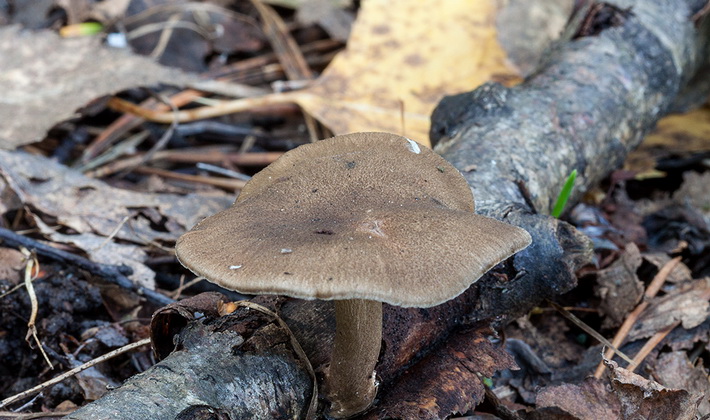
The hat is flat-convex, sometimes with a depression, yellow-brown, brownish, gray-brown.
Young hats can be eaten boiled.
Ecology and distribution:
This tubular mushroom with a white hymenophore grows on knots immersed in the soil, as well as on the trunks, roots and stumps of willow, birch, alder, mountain ash, hazel and other deciduous trees.
Tinder fungus (Polyporus squamosus).
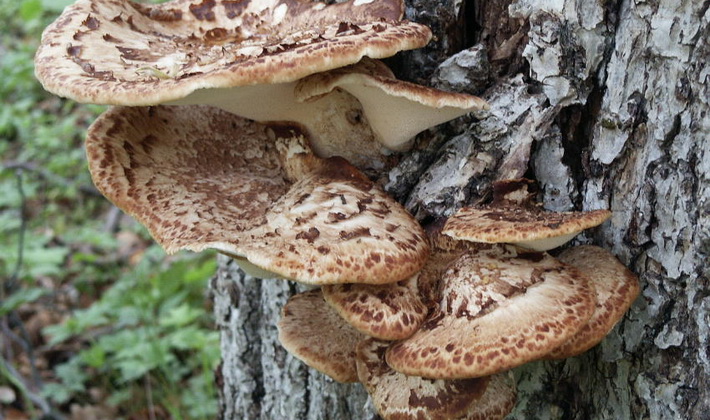
Family: Polypore (Polyporaceae)
Season: mid-May - end of August
Growth: single and in groups; several hats grow fan-shaped, tiled
Description:
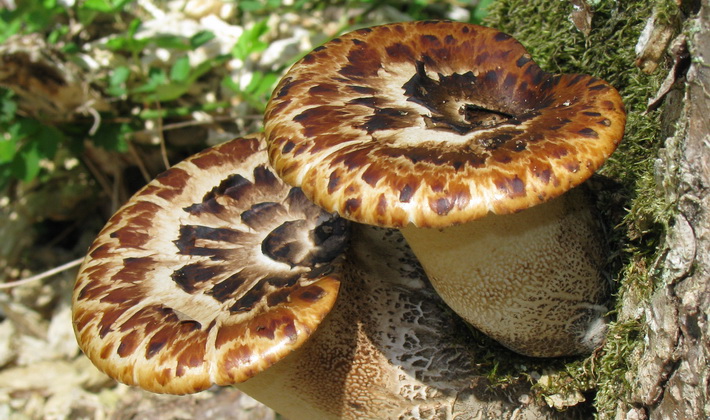
The cap is first kidney-shaped, later prostrate, fleshy, sometimes depressed at the base. The porcine hymenophore, with large angular cells.
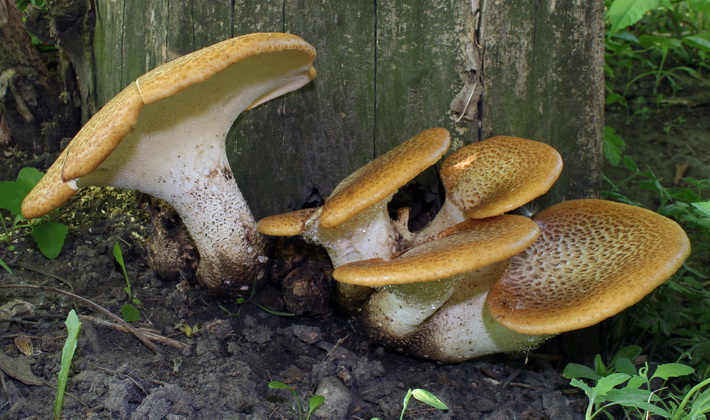
The leg is eccentric, dense, from above - light, mesh, to the base - black-brown.

The pulp is dense, elastic, with a powdery odor, later - hard, stiff.
The surface of the cap is light-colored, grayish-yellow with large brown scales.
The mushroom is edible at a young age. It is used fresh (after prolonged boiling), salted, pickled.
Ecology and distribution: It grows in broad-leaved forests and parks on living and weakened trees (most often on elms).
Tinder fungus (Polyporus umbellatus).
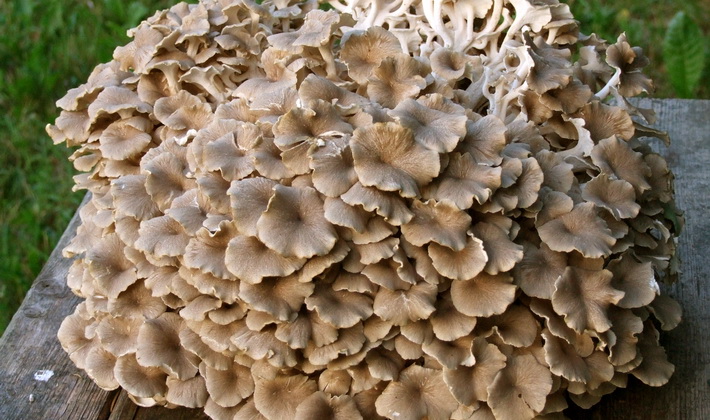
Family: Polypore (Polyporaceae)
Season: beginning of July - October
Growth: single
Description:
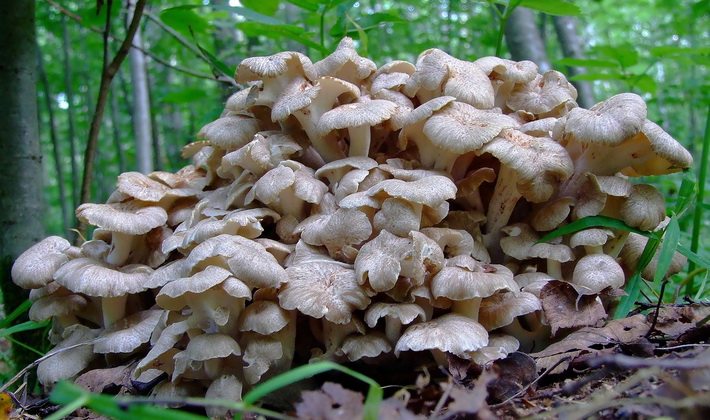
The hat is flat-convex, depressed in the middle, light ocher, later brownish. The tubular hematophore descends to the leg, white.

Fruit body weighing up to 4 kg, rounded, many times branched into petals-caps with a common short light leg.
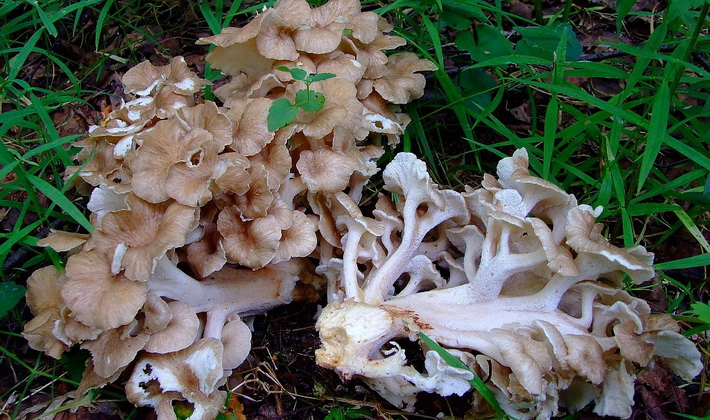
Pulp: white, dense, fibrous, hardens with age.
Edible at a young age.
Ecology and distribution:
This is another fungus that belongs to the tubular. It grows in mixed and deciduous forests at the base of old deciduous trees (oak, birch, rarely maple, linden), on young shoots and near it, on stumps, rotting wood and near it, on the soil. It is rare; listed in the Red Book of Russia.
Variable fungus (Polyporus varius).
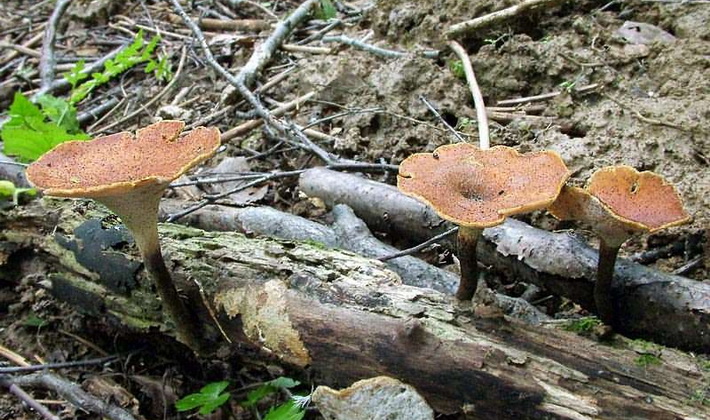
Family: Polypore (Polyporaceae)
Season: end of June - October
Growth: singly and in small groups
Description:
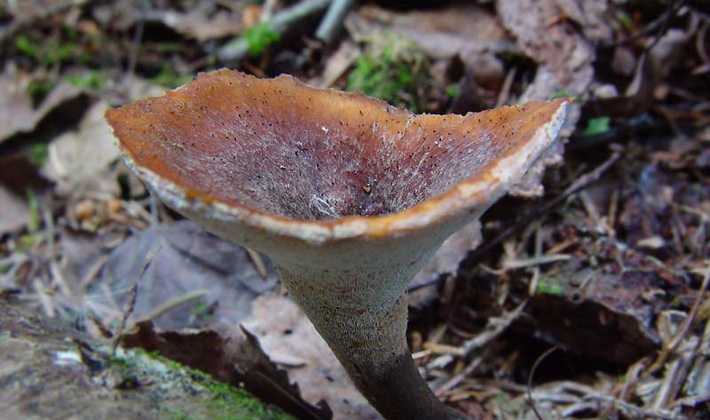
The cap is often funnel-shaped, thin-skinned, light-horned, or yellow-brown; it brightens with age. The hymenophore is finely tubular, white, descending along the leg.
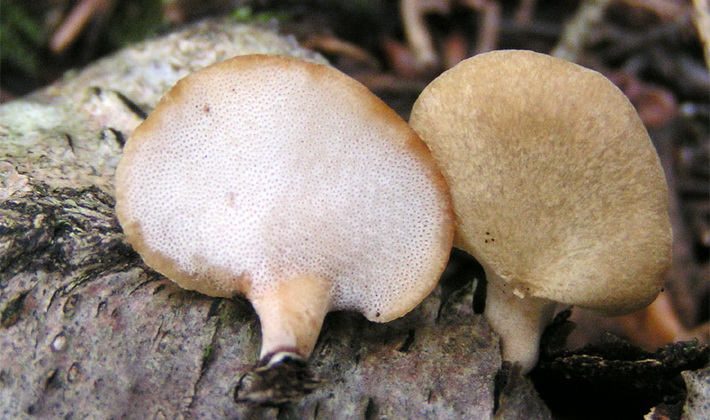
Pulp: whitish, leathery, later woody.
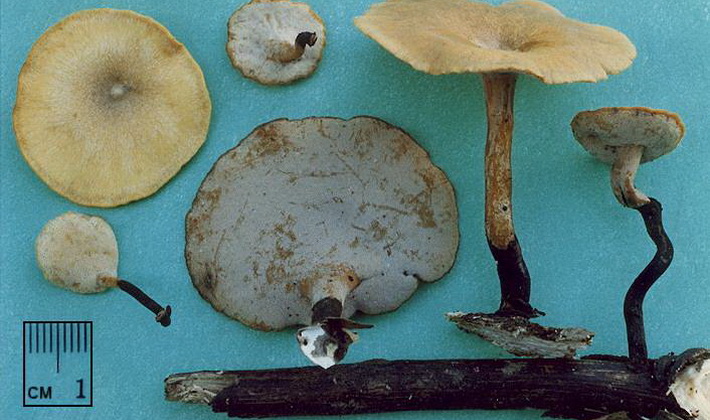
The leg is firm, the lower part is sharply limited by a dark velvety zone.
Inedible due to the solid consistency of the pulp.
Ecology and distribution:
It grows on stumps, in forests, parks, and felled forests of deciduous species (birch, alder, willow, linden, oak, ash), rarely on living trees. It is rare.
In the final section of the article, you will find out what else are tubular mushrooms.
Other tubular mushrooms
Gyroporus cyanosis (Gyroporus cyanescens).
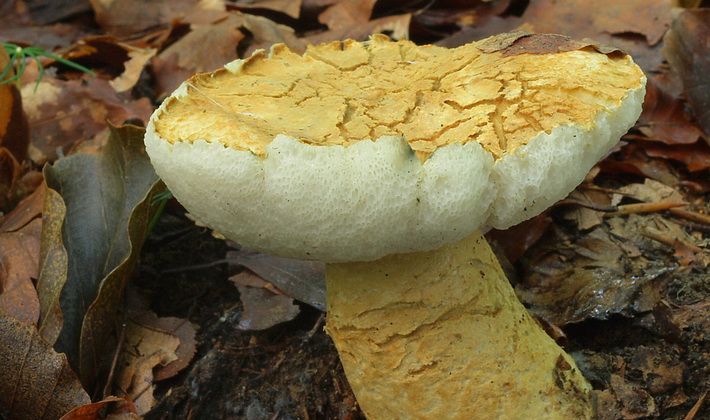
Family: Flight (Boletaceae)
Season: end of July - September
Growth: single
Description:
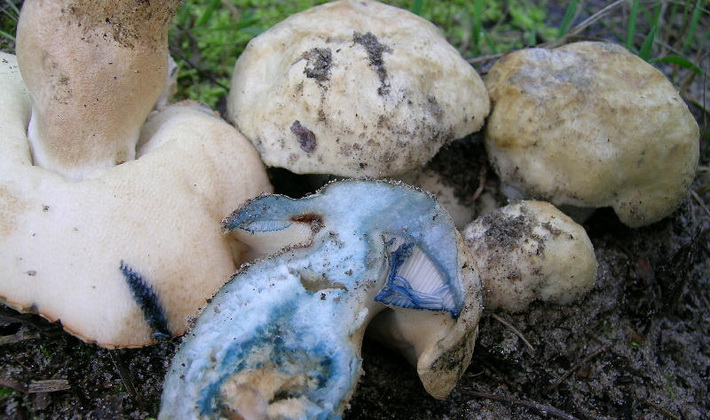
The pulp is brittle, white or creamy, at a break it acquires a characteristic cornflower blue color, the taste and smell are pleasant.
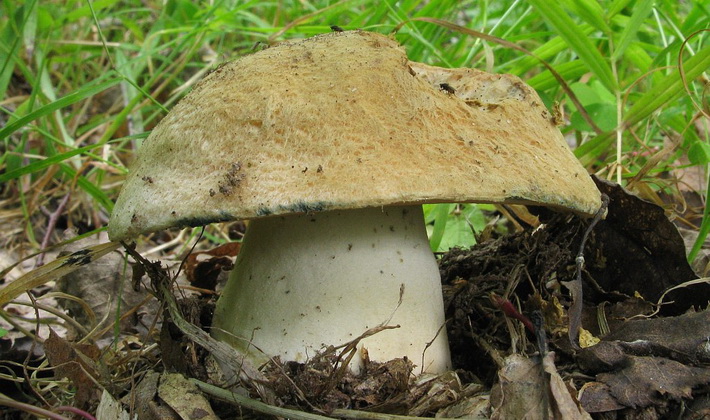
The hat is straw-yellow, brown-yellow or grayish-brown, turns blue with pressure. The skin is dull, velvety, dry. When pressed on the tubes, blue spots remain. The tubes are free, 5-10 mm long, white, yellow with age. The pores are small, rounded.
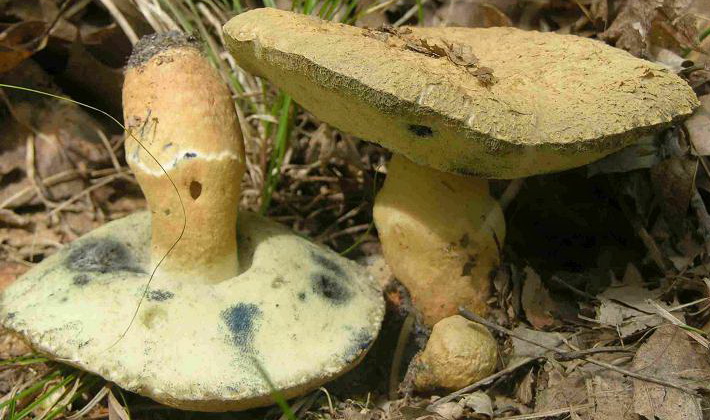
The leg is thickened at the base, initially with a cotton-like filling, voids form with age.
Tasty edible mushroom. Used fresh, dried, salted and pickled.
Ecology and distribution:
Forms mycorrhiza with birch. It grows in light deciduous and mixed forests. Prefers sandy soil. In Russia, it is very rare, listed in the Red Book.
Oak boletus (Leccinum quercinum).

Family: Flight (Boletaceae)
Season: June - end of September
Growth: in small groups
Description:
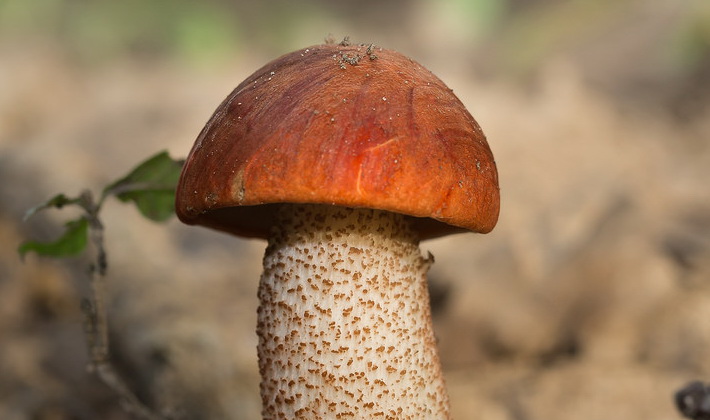
The cap is hemispherical or pillow-shaped.
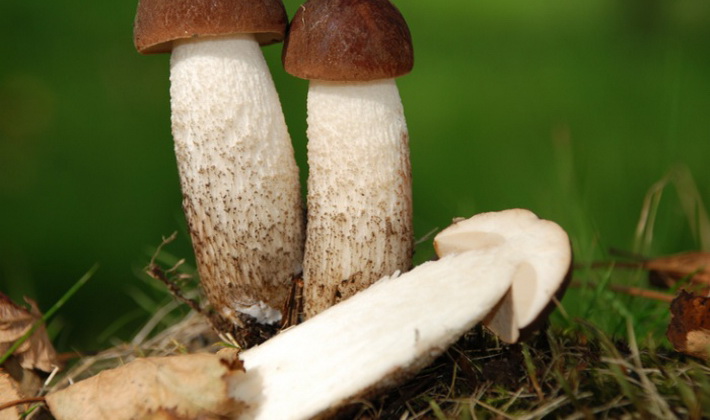
The pulp is white with brownish-gray spots, dense, almost black on the cut. The chestnut skin is brown with an orange tint, it hangs slightly along the edge of the cap. The tubular layer is narrowly grown, 2-3 cm thick, brownish.
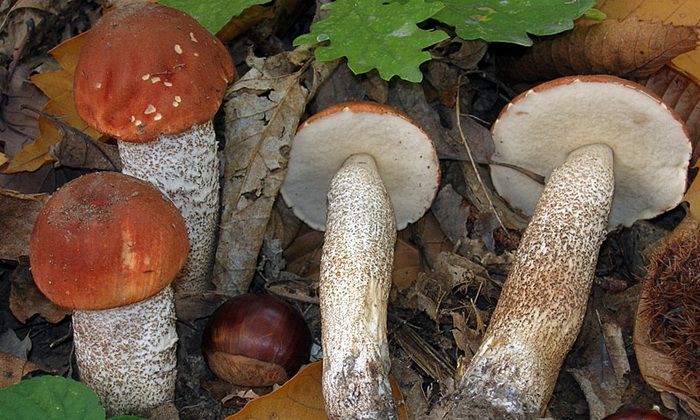
Leg slightly thickened at base, with small reddish-brown scales.
Tasty edible mushroom. Used fresh, dried, salted and pickled
Ecology and distribution:
Forms mycorrhiza with oak. Distributed in forests of the northern temperate zone.
Common boletus (Leccinum scabrum).
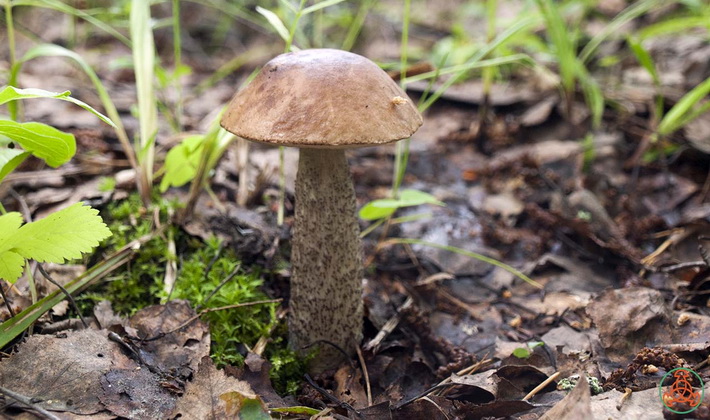
Family: Flight (Boletaceae)
Season: end of May - mid-October
Growth: singly and in groups
Description:

Leg slightly expanded to base, dense, longitudinally fibrous, whitish with dark gray or black-brown longitudinal scales.

The hat is convex, in maturity it is pillow-shaped, dry, dull, brown tones.
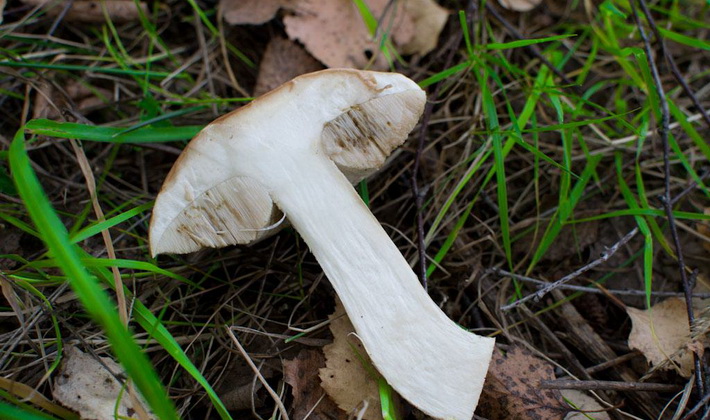
The flesh at a young age is light, dense, tender, later - friable, watery, in the leg is stiff-fibrous. The tubular layer is free, finely porous, light, turns gray and convex with age.
Good edible mushroom. It is used in soups and main dishes (after boiling), dried, frozen, salted and pickled. It usually darkens during processing. It is better to collect young hard mushrooms (the old ones crumple during transportation).
Ecology and distribution:
Forms mycorrhiza with birch. It grows in deciduous and mixed (with birch) forests, in woodlands, in young birches, in the grass.
Chess obabok (Leccinum tesselatum).
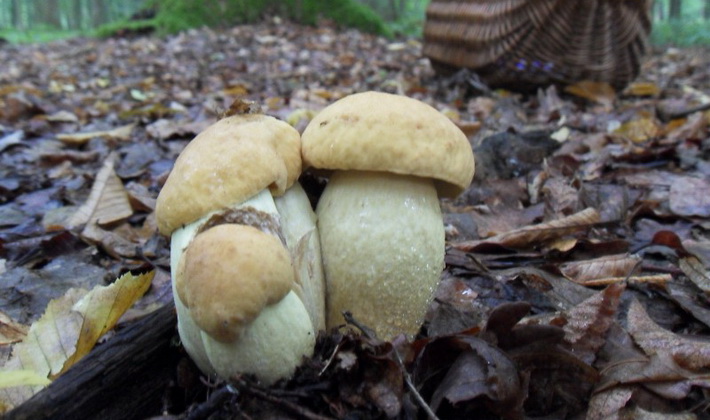
Family: Flight (Boletaceae)
Season: June - September
Growth: singly or in groups
Description:
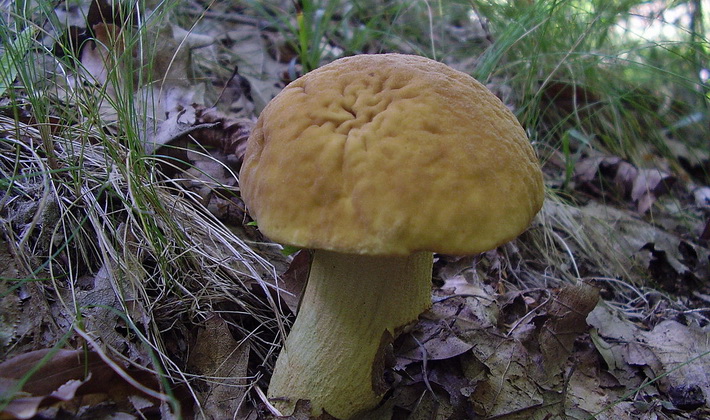
The cap is hemispherical, then cushioned.
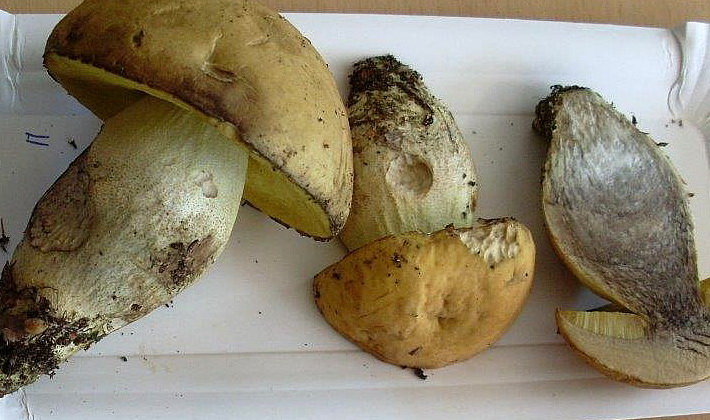
The flesh is light yellow, turns red on the cut, then turns black. The skin is dry, yellow-brown, often cracking. The tubular layer is 1.5-2.5 cm thick, lemon yellow, when pressed, it is painted in lilac-brown.
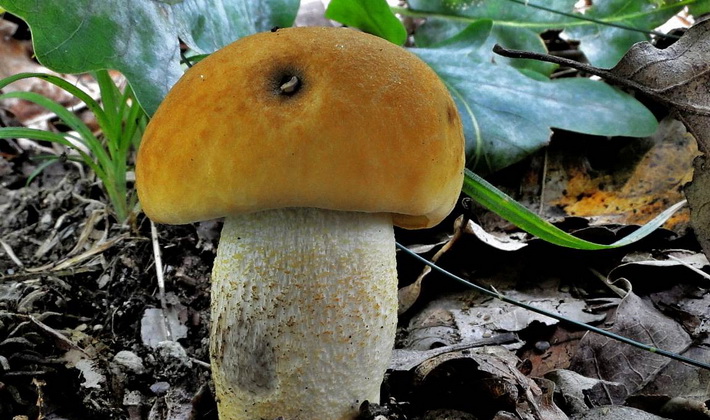
Leg clavate, yellowish, with buffy-yellow scales.
Edible mushroom, used in freshly prepared, dried and pickled form. When drying, it turns black.
Ecology and distribution:
It forms mycorrhiza with oak and beech. Grows in deciduous forests. Distributed in warm regions of Europe, in Russia it is found in the Caucasus.
Bile fungus (Tylopilus felleus).
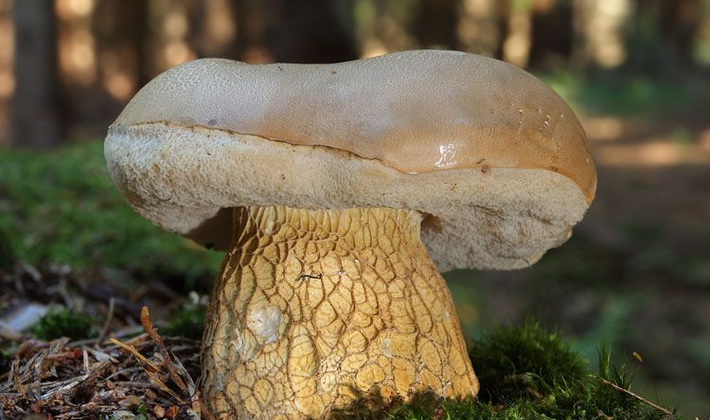
Family: Flight (Boletaceae)
Season: June - October
Growth: singly or in small groups
Description:
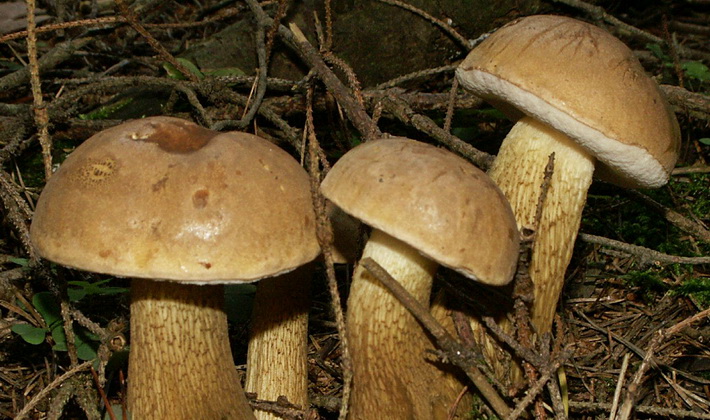
The cap is convex, cushion-shaped. The tubular layer is grown, first white, later dirty pink. The skin is dry, slightly pubescent, later smooth, yellowish-brown, less often chestnut-brown.
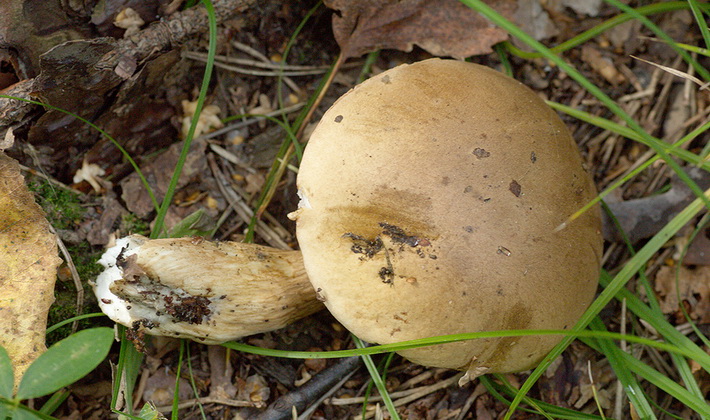
The leg is club-shaped, expanded to the base, yellowish-ocher, with a brown-brown mesh pattern.
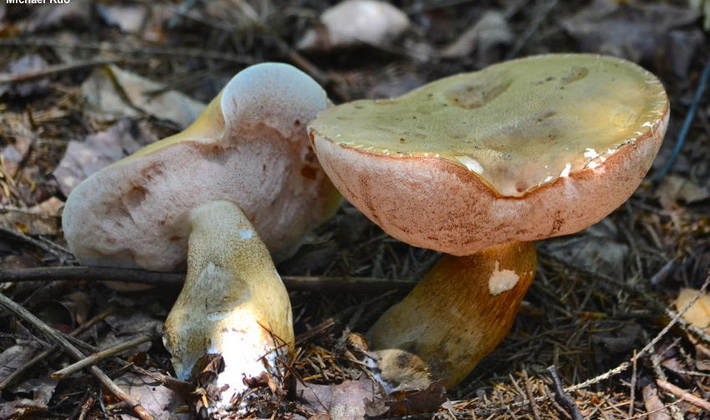
The flesh is white, odorless, with a bitter taste or a burning aftertaste, it turns slightly pink at the cut, and very rarely turns red.
This cap fungus is inedible due to its bitter taste.
Ecology and distribution:
It forms mycorrhiza with coniferous and deciduous trees. It is more common in coniferous forests on acidic fertile soils, often at the base of trees, sometimes on rotten stumps. Distributed everywhere in the forest zone.
Goat (Suillus bovinus).
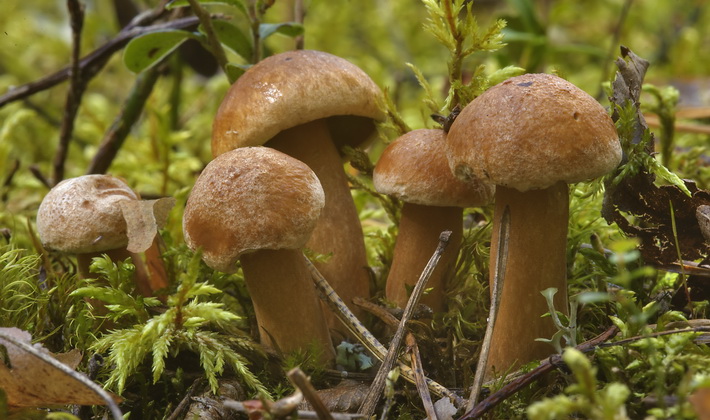
Family: Oiler (Suillaceae)
Season: beginning of July - October
Growth: singly and in groups
Description:

Tubular layer: slightly descending, coarse-porous, convex, brownish-yellowish with age. Leg narrowed often curved, dense, smooth, one color with a hat.
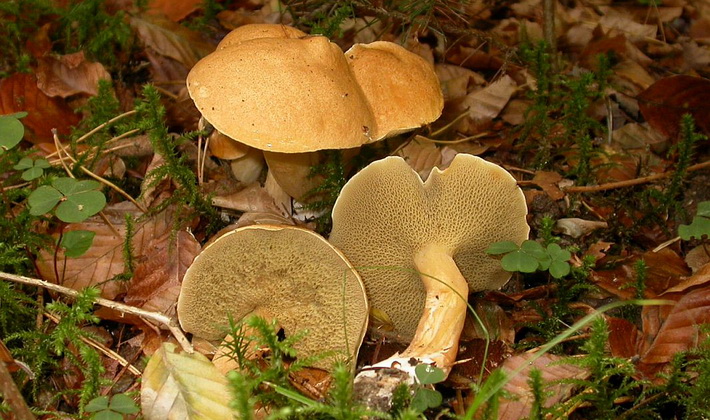
The pulp is dense, elastic, with age - rubbery, yellowish, sometimes turns pink on the cut.
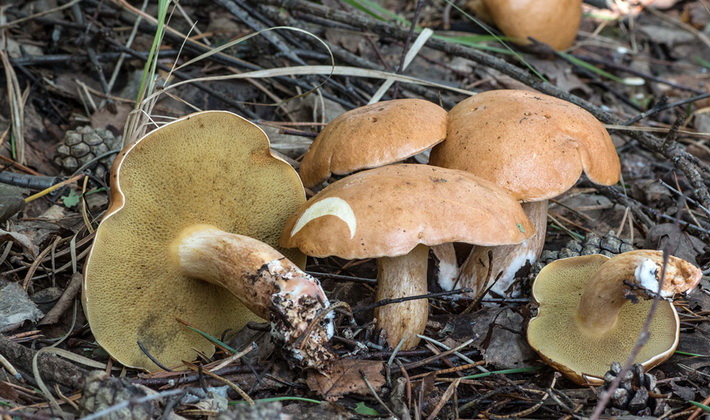
The hat is convex, then flat, smooth, sticky, brown-brown tones.
Edible mushroom of low quality. It is consumed fresh (after boiling), in salted and pickled form.
Ecology and distribution:
It forms mycorrhiza mainly with pine. It occurs in coniferous forests with pine on acidic, nutritious soils in moist places, near roads, in sphagnum bogs.
Granular butterdish (Suillus granulatus).

Family: Oiler (Suillaceae)
Season: June - November
Growth: singly or in small groups
Description:
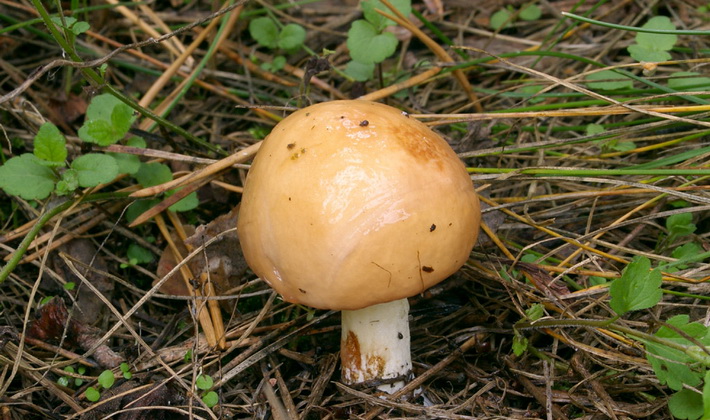
The cap is hemispherical, then cushioned. The skin is smooth, slimy, reddish brown, later ocher-brown.
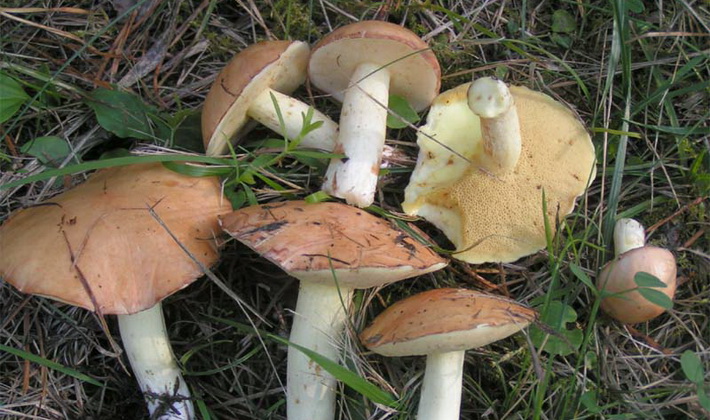
Leg is solid, yellowish, without ring.
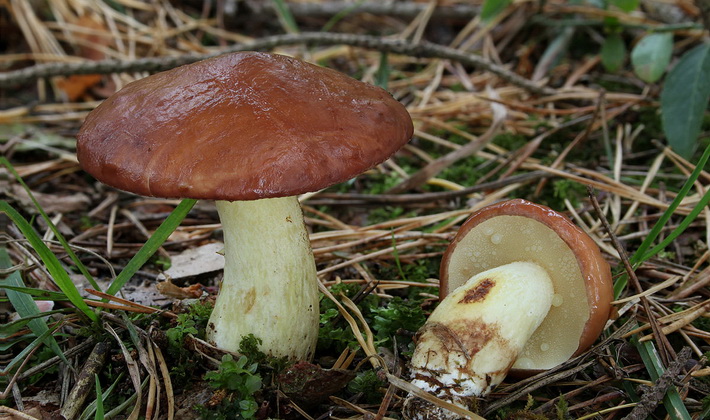
The flesh is fleshy, yellowish, fibrous in the leg, with a mushroom smell. The tubular layer is finely porous, overgrown, yellowish, often with white drops of liquid
Tasty edible mushroom. Before cooking, the mucous skin from the cap should be removed.
Ecology and distribution:
It forms mycorrhiza usually with ordinary pine, less often with other pine trees. It grows in coniferous forests with the participation of pine, on sandy soils, in glades, on clearings, along roads.
Butterfly larch (Suillus grevillei).
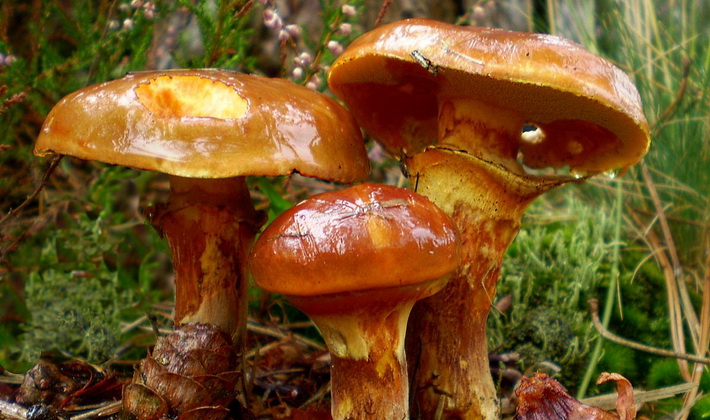
Family: Oiler (Suillaceae)
Season: July - September
Growth: in groups
Description:
With age, the hat becomes flat-convex, then flat. The skin is sticky, smooth, covered with mucus, the color is from lemon yellow to golden brown; removed with difficulty.
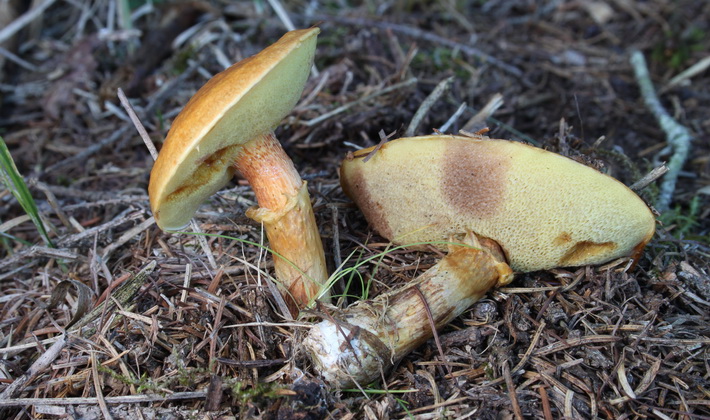
The pulp is juicy, firmly fibrous, yellow, in mature mushrooms it turns slightly pink, then turns brown. A mesh leg, lemon yellow over the ring, is white or yellow in color.

The leg is solid, granular on the top, the color of the leg is the same as the hat or reddish-brown.
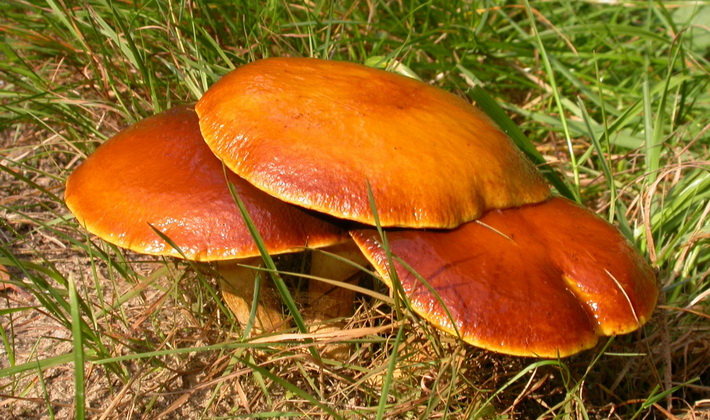
The cap of young mushrooms is cushion-convex.
Good edible mushroom. Requires boiling. The most delicious in marinated form, it is also used fresh (in soups, fried) and salted.
Ecology and distribution:
Forms mycorrhiza with larch. It grows in forests with larch, in plantations, orchards, sometimes fruiting bodies can be found far from the host tree. Prefers acidic, rich soils.
Butterdish (Suillus luteus).
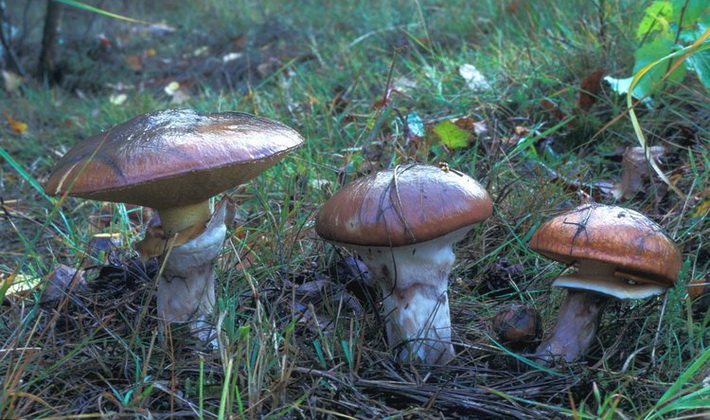
Family: Oiler (Suillaceae)
Season: end of June - mid-October
Growth: in groups
Description:
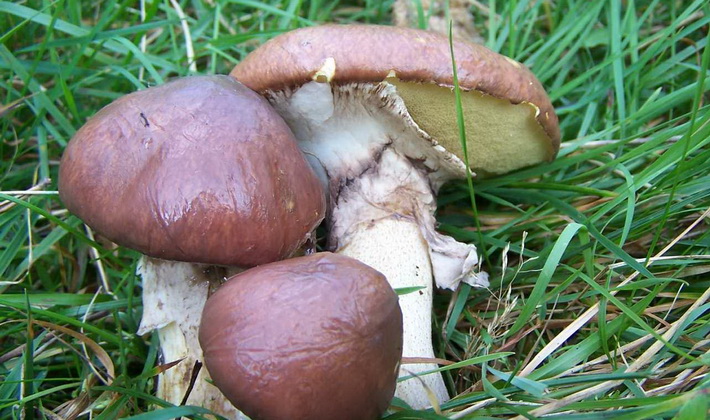
The tubular layer is grown, slightly descending, the pores are yellowish, olive-yellow, small, angularly rounded, turn brown with pressure. The tubular layer is initially covered with a yellowish membranous coverlet. The mucous skin is easily separated from the pulp, the color is from brown to brown.
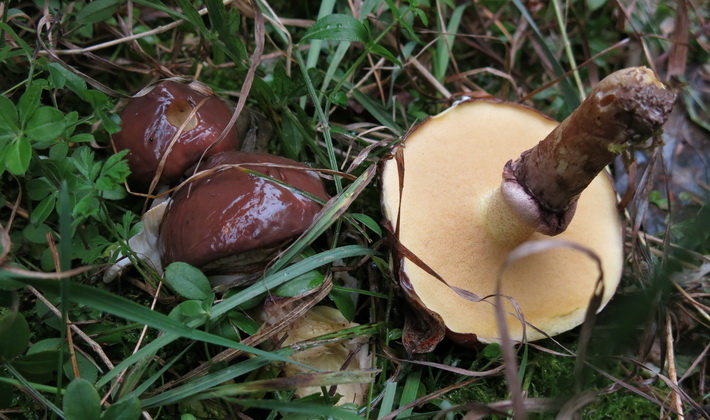
The flesh in the hat is juicy whitish or yellowish, rusty-brownish at the base of the leg. The ring is brownish.
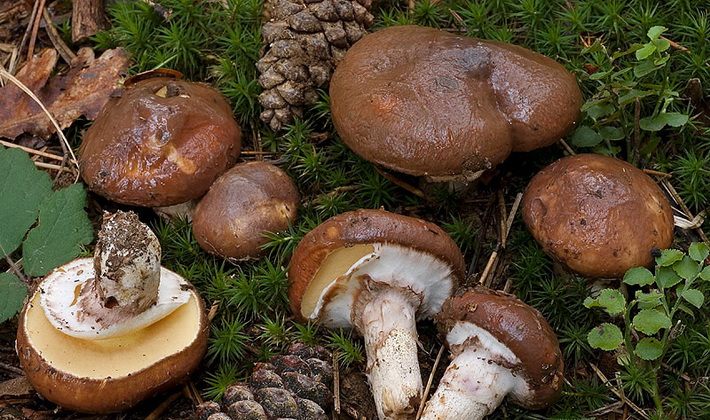
The leg is continuous, longitudinally fibrous, whitish. The cover of young mushrooms is white.
It is considered the most delicious among oilers. When pickling, the mucous skin from the cap is best removed.
Ecology and distribution:
Forms mycorrhiza with pine. It grows in light coniferous, as a rule, young pine forests and plantings, in the grass, on the edges, on the side of roads. Prefers sandy soil and places with good lighting.
Sheep Mushroom (Albatrellus ovinus).
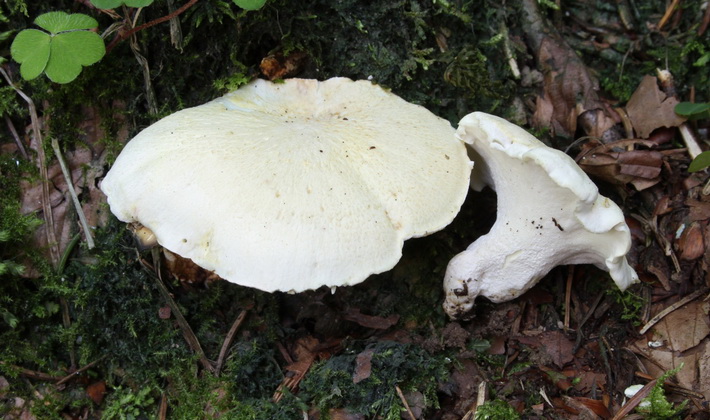
Family: Albatrellaceae
Season: July - October
Growth: large intergrown groups, less often singly
Description:
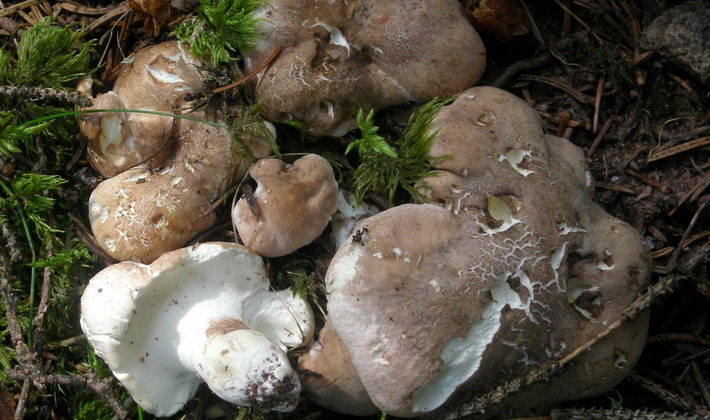
The hat is fleshy, dry, with an uneven tuberous surface, color from white to gray-brown.
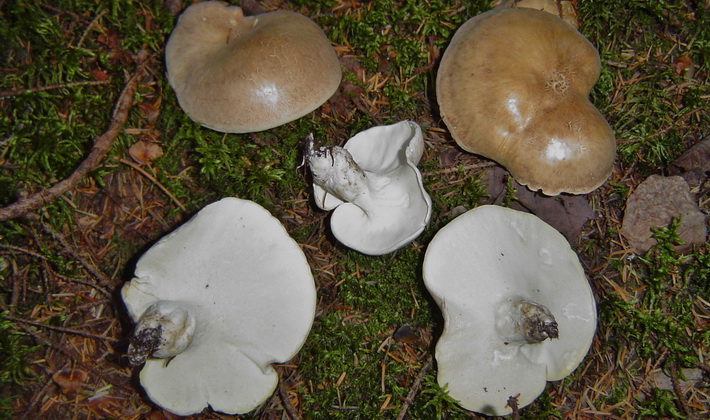
The pulp is dense, brittle, white, yellowing when dried, with a soapy smell.
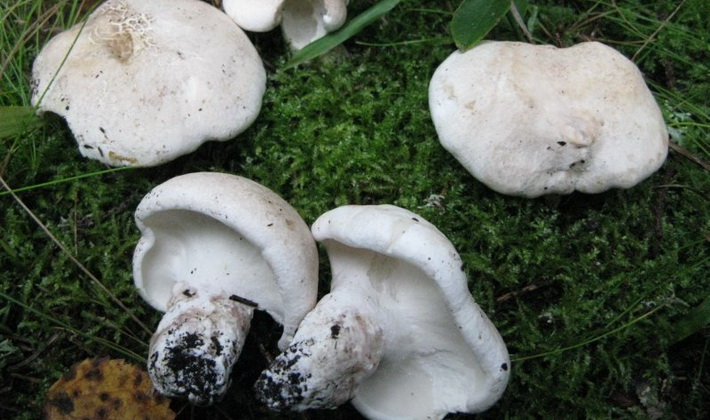
The leg is smooth, continuous, sometimes eccentric, narrowed to the base, white to light brown in color. The tubular layer runs down strongly on the leg, 1-2 mm long, white or yellowish.
Only young hats are used in food (after boiling). In some people, it can cause an upset digestive tract.
Ecology and distribution:
It grows on soil beneath fir trees in dry coniferous and mixed forests, in clearings, clearings, forest edges, along roads.
Pepper Mushroom (Chalciporus piperatus).
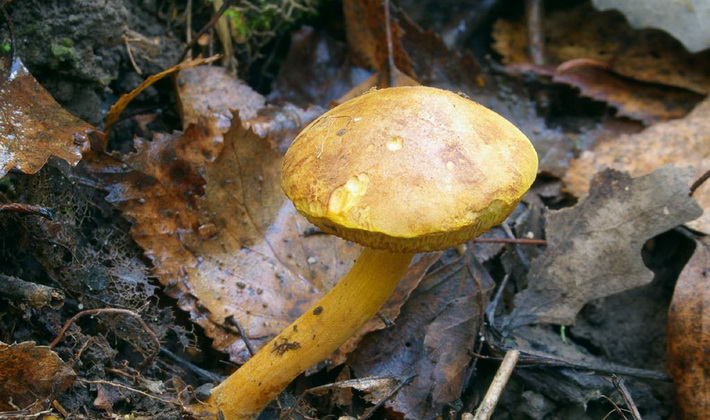
Family: Flight (Boletaceae)
Season: July - October
Growth: singly or in small groups
Description:
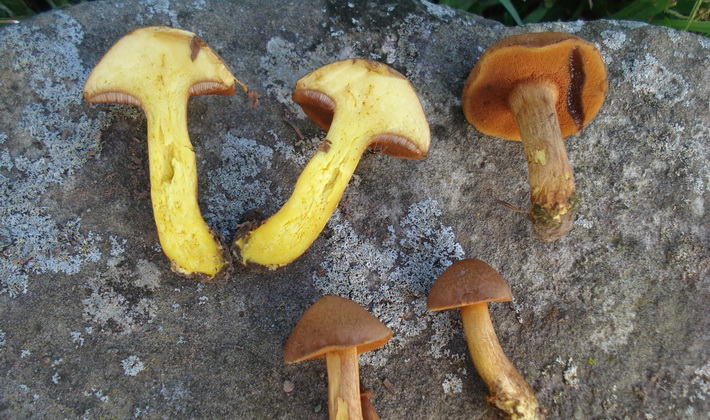
The flesh is friable, yellowish, sulfur-yellow in the leg, slightly blushes on the cut, with pepper taste.
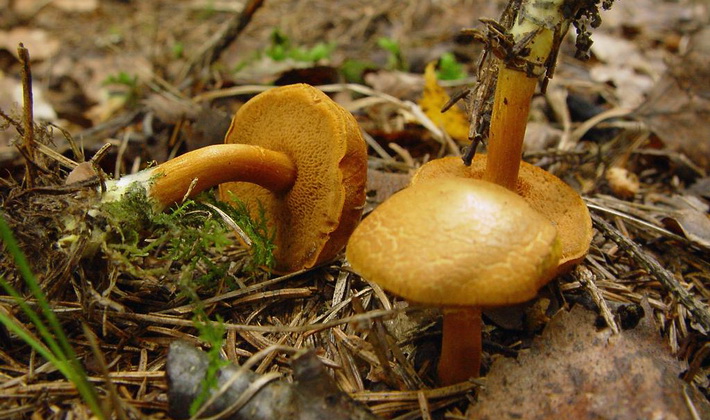
The hat is smooth, slightly sticky, brown tones. The peel is not removed from the cap. The tubular layer is grown or down, the pores are reddish-brown, large, angular.
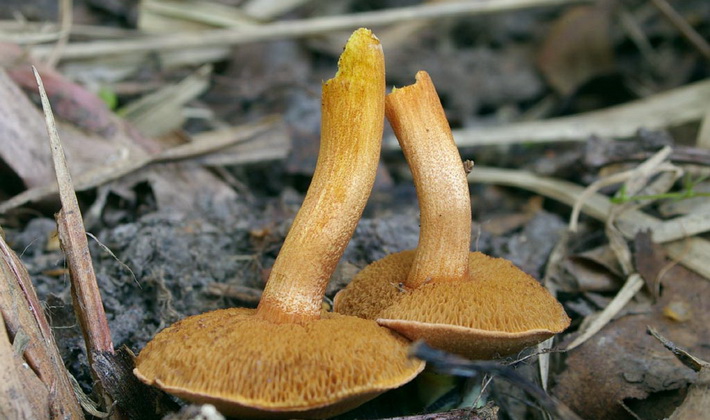
The leg is solid, dense, brittle, the color is the same as the hat.
It is considered inedible, but can be used in small quantities as a spicy seasoning; boiled and cooked gives the dish a slight bitterness.
Ecology and distribution:
Forms mycorrhiza with pine. It grows in coniferous forests with pine, less commonly in spruce, mixed and deciduous forests.


